



In September 2024, people of all ages—residents, workers, visitors, holidaymakers, and passionate fans of Felixstowe in East Suffolk—came together to time-travel into the future of this coastal town with their friends and neighbours.
This small-scale event to explore community needs and aspirations was a key step in shaping Furtherfield’s future in the town, as we plan our relocation from London to Felistowe. Film-maker Hydar Dwatchi created a film about the event.
It’s important to use our imaginations to create the futures we want
“It just reminds us that we have to bring our creative imaginations to the future that we want. – It’s playful, it’s going to make a lot of people think, it’s going to surprise a lot of people” – Adrian
This experience made it more fun and less worrying to exploring the future
“It brings up serious issues while you are allowed to have a bit of fun with them. But also in a way allowing you to disassociate so your prime self doesn’t have to worry about them, because it’s this future self” – Mark
It’s important to respect ideas and feelings of young people in this town
“It’s great to involve younger people who don’t always get involved in these conversations because we feel a bit disenfranchised, and we feel a little bit pushed out by the older generation sometimes. In Felixstowe, it seems to be an older population…we are trying to get a place for younger people to be collectively together and work with you guys so we can make something we are ALL proud of. It’s just great to have a platform to be able to share ideas and feelings about Felixstowe and have them listened to and respected by everybody.” – Courtney
🚢The port was founded in 1875. Looking back 150 years, we can see the changes it made in this town.
During this event we asked ourselves how, in 50 years, we will we look back on this time with all the changes we know are coming, including new developments and shifts in climate?
🌞Felixstowe is a place that radiates healthful living and wellbeing. The land and sea support livelihoods, leisure and blooming biodiversity. The port, the largest in England, provides crucial national infrastructure and contributes to a healthy local economy. In the summer holidaymakers flock here.
🌬️But things are always changing here and in the wider world. In May, Furtherfield invited local residents to chat about the futures we want. In July, we shared what we discovered with three creative practitioners from the region: Mimi Doncaster and Frazer Merrick, and Kirsty Tallent. Together we created an immersive future fiction that formed the basis of a public event to work on the future together!
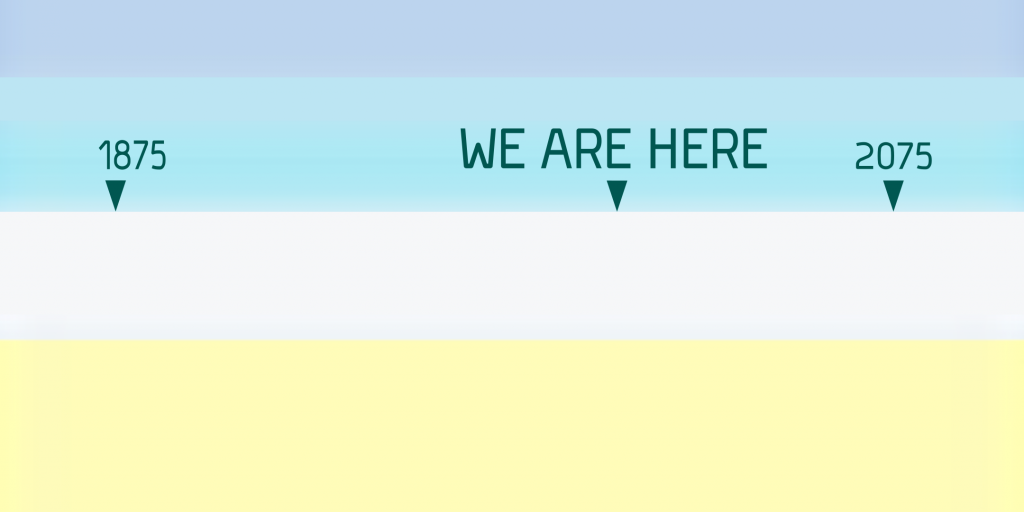
⏰We created a timeline of Felixstowe since the port was founded in 1875 and added events of historic or personal significance.
✨Then we chose our time-travelling characters. Starting as a young person, or an elder we decided what our character cares about?
We travelled all the way to 2075, the year the Multispecies Port of Felixstowe opens.
This event was co-devised by Ruth Catlow (Furtherfield), Mimi Doncaster, Ann Light (University of Sussex), Frazer Merrick, and Kirsty Tallent. Thanks to Hamilton MAS for hosting the co-creation workshop and to Cuppa for hosting the community conversation that inspired and informed our work. Thanks to Courtney Hessey for guidance on youth empowerment
In an 18 month project Reimagine This Coastal Town in Felixstowe over Summer 2025 and 2026 we are going to host a programme of events, workshops, and an exhibition, culminating in an eco-social Live Action Role Play (LARP), co-produced by 18+ young adults and eight creative practitioners from the region.
A proven way of generating visionary new worlds, we aim to inspire community-led environmental and social transformation in Felixstowe, enabling residents to collectively reimagine its future in the context of eco-social change, with a particular focus on youth empowerment and reaching marginalised communities in the town.
This project will be realised in partnership with The University of Sussex, Level Two Youth Projects, Hamilton MAS, and the Felixstowe Citizen Science Group and with support from Arts Council England and the Suffolk Cultural Fund.
Welcome to This Coastal Town Reimagined: 200 Years Of Change!
For adults of all ages. If you are a resident, worker, regular visitor, or if you just love Felixstowe, this is for you! Join us for a fun morning or afternoon with your friends and neighbours, time-travelling into the future of this coastal town.
FREE – but booking is essential as places are limited
A chance to explore 200 years of change in Felixstowe!
🚢The port was founded in 1875. Looking back 150 years, we can see the changes it made in this town. In 50 years, how will we look back on this time with all the changes we know are coming, including new developments and shifts in climate?
🌞Felixstowe is a place that radiates healthful living and wellbeing. The land and sea support livelihoods, leisure and blooming biodiversity. The port, the largest in England, provides crucial national infrastructure and contributes to a healthy local economy. In the summer holidaymakers flock here.
🌬️But things are always changing here and in the wider world. In May, we invited local residents to chat about the futures we want. In July, we shared what we discovered with three creative practitioners from the region: Mimi Doncaster and Frazer Merrick, and Kirsty Tallent. Together we created an immersive future fiction. That is the basis of the event we are inviting you to here. Come and work on the future together! ⏳
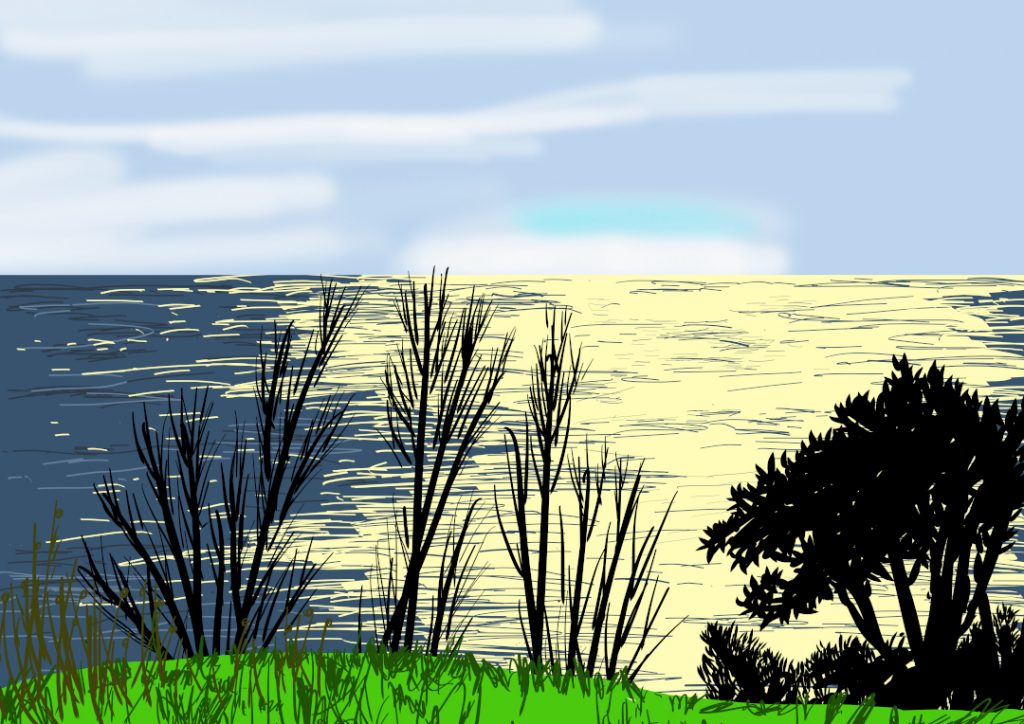
⏰We start with a timeline of Felixstowe since the port was founded in 1875 and an invitation to add events of historic or personal significance.
Then we choose our time-travelling characters. Will you start as a young person, or an elder? What does your character care about? ✨
We will travel all the way to 2075, the year the Multispecies Port of Felixstowe opens.
This event is hosted by The Alex Brasserie, with views of the sea and a cafe bar where you can buy any refreshments around the event. Please tell us about any access needs you may have.
Participants need no prior knowledge or experience to join this event. However, if you are unsure about sustainable futures and are someone who likes to come prepared, we think these links offer a good starting point: What is climate change? A really simple guide, from the BBC, and Sustainable Development Goals from the UN.
Ruth Catlow is co-founder and director of Furtherfield and an artist and organiser interested in how different creative processes can unleash community imaginations to open up new more mutualistic futures in places.
Prof Ann Light is a researcher studying to what extent people can be transformed by encounters with the arts.
Please note that the event is being included in a research project on the effect of immersive experiences. A researcher will be there to observe the event. Although the researcher will not be observing individuals, there is an opportunity on the day for you to decide if you wish to be part of the research or not. If you would like to know more about the research project before the event, please email Professor Ann Light at the University of Sussex (ann.light@sussex.ac.uk) and she will send you an information sheet.
This event has been co-devised by Ruth Catlow, Mimi Doncaster, Ann Light, Frazer Merrick, and Kirsty Tallent. Thanks to Hamilton MAS for hosting the co-creation workshop and to Cuppa for hosting the community conversation that inspired and informed our work.
🙋Please contact Ruth by email ruth.catlow@furtherfield.org if you have any questions, or come early to talk to us.
Saturday 11th November
A Free All Day Event in Finsbury Park
Future Machine creates rituals for when the future comes. It will next appear in Finsbury Park on Saturday 11th November 2023.
When the Future Comes is a series of artist’s interventions each witnessed by a mysterious and mystical device – the Future Machine, led by Rachel Jacobs. A newly formed ritual or special occasion will emerge as the Future Machine appears in Oxfordshire, Nottingham, Cumbria, Somerset and London every year – until 2050 the year scientists predict will be a watershed for more extreme climate and environmental change.
From 10.00 am
Future Machine will meander around the park, meeting people along the way.
11.00 am
Join Future Machine and artists Esi Eshun & Rachel Jacobs for a guided walk to seven trees.
Gather outside Furtherfield Gallery (by the playground, close to the lake at the top of the hill).
From 2.00pm
Meet Future Machine and speak to the future at Furtherfield Commons (between the Seven Sisters Road & Finsbury Park Gates).
Celebrate the weather with musicians from around the world and take part in family activities including drumming and dancing.
Listen to live West African fusion music performed by the group, Zantogola!
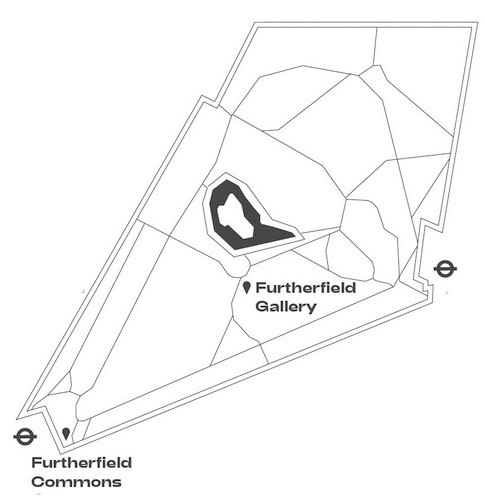
Supported using public funding by Arts Council England, Furtherfield, Horizon (University of Nottingham) and in-kind support from Primary and the British Antarctic Survey
In 2021 we rolled out our new format for presenting accessible open-all-hours digital artworks in Finsbury Park called the People’s Park Plinth. In parallel, we launched our CultureStake collective cultural decision-making app.
Thousands of you showed up online and in the park to experience a set of interactive artistic proposals for larger artworks. Each one presented its own mini-experience in the park and online using web apps, free data, and AR technologies. Three times as many people got involved with our programmes and ultimately picked Based On A Tree Story for their summer 2022 art experience.
Since then we’ve been busy working with HERVISIONS and Bones Tan Jones, respectively the curator and artist behind Based on a Tree Story, to build the full digital art experience and install it in the park.
Now, we’re extremely excited to tell you that from 13th August the tree sprites of Finsbury Park will be ready for you to find them.
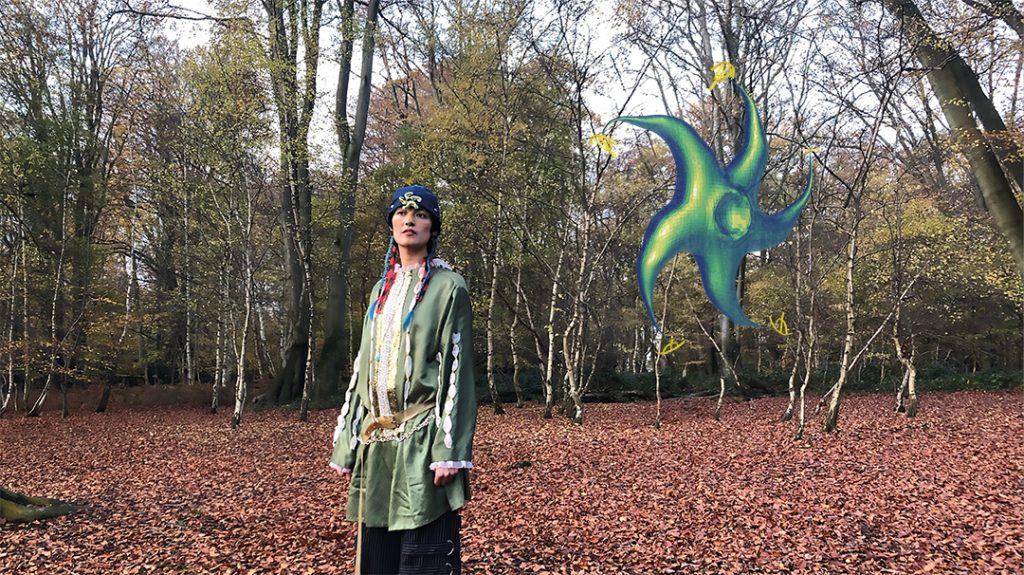
The trees of Finsbury Park bear witness to myriad happenings. Through deep time they wait, they watch, they grow – wiser, wilder…. In this new commission by HERVISIONS X Bones Tan Jones, the special stories of the trees are translated by three mystical sprites that live within the trees, becoming their voice. Use the map to locate clusters of trees and identify the amulet wearers among them. With the app open, scan the symbol to summon the sprite and release a cascade of tree wisdom – time travelling to the roots of their having-beens into the twiggy tips of their future-becomings. And as you crisscross the park, seeking out your next sprite, imagine the ley lines you draw onto and into the earth – and cast your own connective spell.
“We invite you to visit the tree, call forth the sprite and dance together. Let your feet connect to the soil and the movement of the sprite inspire your rhythms. Stomp on the ground and the layers of earth from years of life will reverberate with your sound! Hear their echoes!”
– Zaiba Jabbar, HERVISIONS
To celebrate this amazing news, we’ve invited you to join us for a magical sundown experience seeking out and – if they’ll let you – dancing with the tree sprites of Finsbury Park.
Furtherfield Gallery, Saturday 13th August 2022 from 5pm

HERVISIONS
Responsible for curating, commissioning, conceptualisation, and research HERVISIONS is a femme-focussed antidisciplinary curatorial agency supporting and promoting artists working across new and emergent technologies, and platforms with a strong focus on the intersection of art, technology and culture.
IG: @hervisions_
Bones Tan Jones
Responsible for conceptualisation, research, and artistic production, Bones Tan Jones’ work is a spiritual practice that seeks to present an alternative, queer, optimistic dystopia. They work through ritual, meditating through craft, dancing through the veil betwixt nature and the other. Bones weaves a mycelial web of diverse, eco-conscious narratives which aim to connect, enthral and induce audiences to think more sustainably and ethically. Traversing pop music, sculpture, alter-egos, digital image and video work, Bones sanctifies these mediums as tool’s in their craft.
IG: @yaya.bones
Studio Hyte
Responsible for the visual identity, 3D modelling and technical development, Studio Hyte is a South London-based design studio. Working between graphic design, interaction, and emergent communication. We specialise in forward-thinking, multifaceted visual identities and experiences within the arts and education sector. Our aim is to create meaningful, accessible and thought-provoking work.
IG: @studiohyte
We are building CultureStake, the world’s first collective cultural decision making app (using Quadratic Voting on the blockchain) because we want to enable all communities to choose the creative experiences they want to have in their own areas. The original idea was driven by an awareness that top down arts programming is increasingly problematic. We wanted to find a way to give more people more of a say in what art and culture gets produced in their neighbourhoods – and more opportunity to be the co-creators. In a nutshell, our mission is to put the public at the heart of public arts.
Communities
We want communities to explore and learn together what we all want to experience in our localities. For example how might a theatre audience cast a play differently or a park community curate a public art exhibition?
Cultural Organisations
We want deeper, richer and more open consultation with the communities cultural organisations work for. For example, how might a city council find out which new artwork should occupy a recently vacated public plinth. Or how might an arts organisation discover which artist on their shortlist should be next summer’s blockbuster?
For Everyone
We want a data commons that widens the conversation about how art is valued by different communities around the world. For example, how might our ideas about culture change if we can see what’s important to other people?
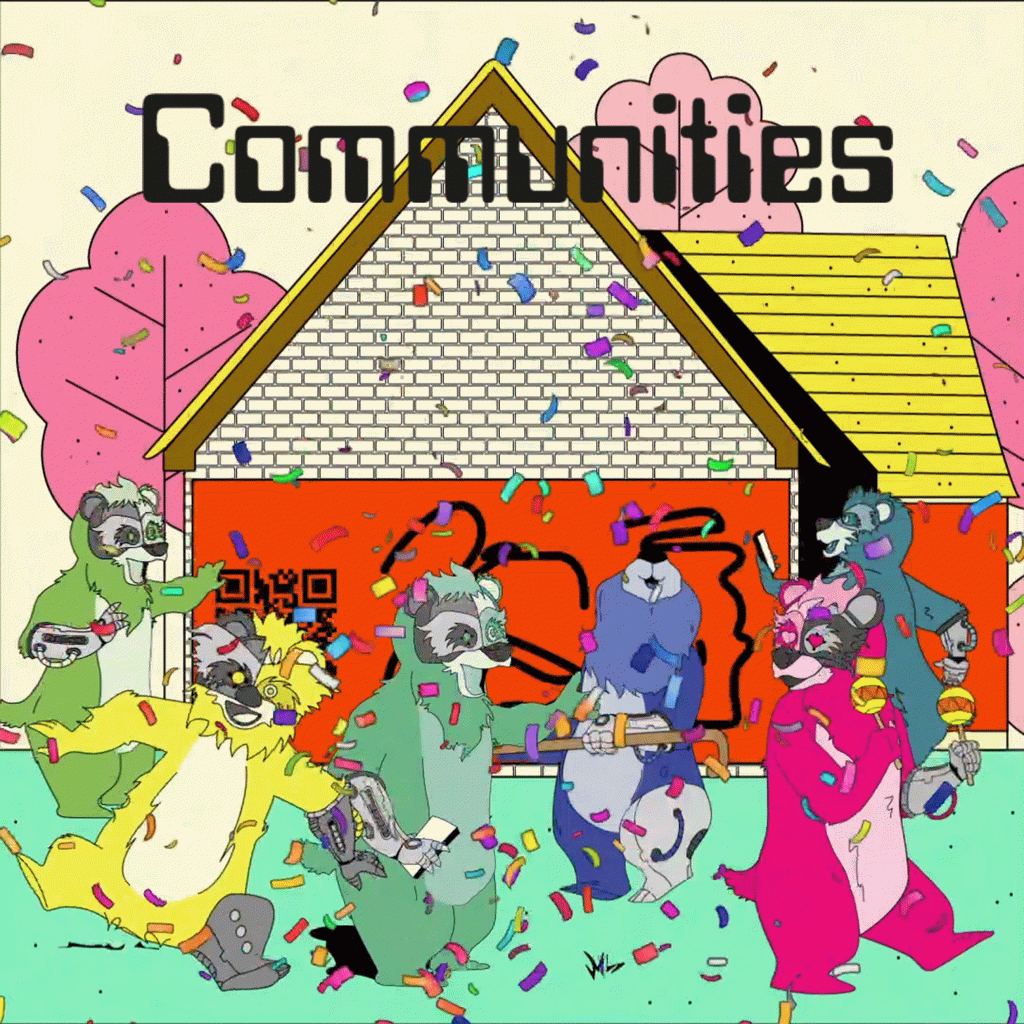
We are using Quadratic Voting because it takes us all from confusing numbers to nuanced feelings.
In QV voters receive a number of ‘vibe credits’ which they can allocate to different creative proposals to express their support. The quadratic function means that showing a strong preference comes at a credit cost. Or rather:
This means that QV is quite unlike any other voting process. Indeed, unlike a one person one vote system, in QV votes express not just what we care about but how much we care! This matters because one person one vote systems usually don’t present the reason why someone voted the way they did or how strongly they felt about it. Politics have taught us not to trust the way votes are interpreted. Voters’ intentions are often misrepresented and communities are polarised about the limited information. Whereas QV allows us to express the intensity of our convictions, giving each of us:
Plus we’ve designed CultureStake so vote organisers can weight the votes of those closest to the issues that matter. For example, in our use of CultureStake for the People’s Park Plinth, any votes cast inside Finsbury Park mean more overall. So those most affected get more of a say.
And we run all CultureStake votes on the blockchain because the blockchain is like a big indelible ledger. This means that a vote cannot be rigged and is always stored extra safely so what we can promise voters is that they can trust our system.
There are many ways to run a CultureStake vote. A theatre could develop an unfinished performance and ask communities to choose the next steps. An arts organisation might offer up a range of different events and invite communities to choose what they want to encounter. Either way, the voting system doesn’t rely on asking everyone to just pick their favourite, but rather explore their thoughts and feelings in relation to a set of questions. So the result is always knowing more about what communities think and feel. Plus, we never show what ranked 1st, 2nd, or 3rd, but rather what was selected and what thoughts and opinions drove people’s selections.
At Furtherfield we are using CultureStake to power our People’s Park Plinth initiative in Finsbury Park. The concept behind the People’s Park Plinth is that our Finsbury Park buildings and even the park itself will act as a plinth for public digital artworks chosen by our communities using our CultureStake app.
The Gallery building will therefore provide an interface where people can scan hoardings to access works which offer a range of XR-enabled experiences in the park. Annually there will be a set of ‘proposal’ artworks, which will give people a first glimpse at what can be created more fully later in the year. Everyone will have time to explore these proposals and then use CutlureStake to choose what they want.
In our pilot year we tripled local engagement and received amazing local feedback like this:
“I live nearby and I’ve been talking about this with my friends for months, it’s such a great idea, to give people a say!”
“[…]decentralisation allows people to have slower but more grassroots-based management of any decision making.”
“I think it’s good that we have a say as well. And I really love voting.”
“Usually I guess I choose art by going to a place and supporting it like that but I’ve never been involved so much in really deciding on what I will see next. And yeah it makes me actually feel good too.”
“[…] quite a lot of times actually […] art is reserved only for the higher echelons of society and I feel like this is really nice that anyone can come in and you vote for who you like or what art you like.”
“I do feel represented…”
We are now in the next phase of development and are actively looking for partners from different types of venues and communities to partner with us so we can explore their unique needs and ensure we have a robust system.
If you are a small, medium, large, networked, physical, touring, online or any other type of cultural entity that wants to deepen your community connections we would love to hear from you. We want to know how you would use CultureStake in your own context and what you would like to achieve. To find out more contact Charlotte and she’ll arrange a meet up.
Our new initiative in Finsbury Park, the People’s Park Plinth, cedes co-curational and co-creational control of our cultural activities to the people of the park. It’s your park, it’s your pick!
We believe that if there is more accessible cultural activity in the park, and more people have more of a say in those activities, then the activities will be more representative of local communities and issues, more people will participate, and more people will feel more of a sense of community and connection within the area.
We have therefore developed the People’s Park Plinth to operate as a dedicated place-shaping initiative bridging the histories, values, physical location, needs, and social practices of local communities. We aim to connect people to the park, surrounding areas, and each other, through free co-creational public digital arts activities which nurture and strengthen community cohesion alongside the biodiversity of the park itself.
We will work collaboratively via place-based partnerships to support and involve communities in ambitious high-quality cultural experiences and improve access to a range of cultural activities where people live, by:
Turning the whole of Finsbury Park into a plinth for free, open-all-hours, mobile-first, co-creational, digital visual art programmes curated and created by, for, and with the local community.
To do this we will invite local people to set the curatorial remit for the People’s Park Plinth as a public art project that starts with them and the natural habitat of Finsbury Park.
Every year we will:
In 2021 we ran our pilot year for the People’s Park Plinth and tripled our local engagement.
We will shortly unveil the park’s pick for 2022: Based On A Tree Story which allows everyone to explore the park looking for tree sprites which tell the histories of Finsbury Park trees and encourage you to dance with them.
In 2023/24 the People’s Park Plinth will take on the theme of local biodiversity. Working with local groups we have developed a project called the Interspecies Festival of Finsbury Park which imagines a a not too distant future where there has been unrest among all the species inhabiting Finsbury Park. After much protest it has been agreed that a treaty of cooperation will be drawn up. But first there will be an Interspecies Festival to ensure all the species understand each other’s cultures and needs. Therefore proposals for the plinth will take the form of video presentations by a range of Finsbury Park species each pitching for which park habitat and activities should feature in the forthcoming Interspecies Festival. We will facilitate voting and then support the artist(s) in producing a series of workshops to prepare for the Festival, before hosting the Festival itself in August 2023 and presenting a virtual exhibition of Festival activities and footage.
“In The Treaty of Finsbury Park 2025, we are catapulted several years into the future where all the species of the park have risen up to demand equal rights with humans. After much unrest, it has been agreed that a treaty will be drawn up, designating these rights, but first humans must learn to better relate to and understand non-humans so they can cooperate better together. Thankfully there has been a new invention – The Sentience Dial – which allows humans to tune into all the flora and fauna of Finsbury Park.”
WHAT’S ON NOW: THE TREATY SIGNING
The Treaty of Finsbury Park 2025 is a collaborative project that depicts the story of the dawning of interspecies democracy. It’s a new era of equal rights for all living beings, where all species come together to organise and shape the environments and cultures they inhabit, in Finsbury Park (and urban green spaces across the UK, the world, and beyond!) Like many urban parks, Finsbury Park is fraught with environmental issues from noxious gasses and traffic noises to governance struggles and financial sustainability. If colonial systems of dominance and control over living beings continue we all face an apocalypse.
Based around a set of LARPs – or live action role play games – the Treaty of Finsbury Park 2025 is played from more-than-human perspectives to encourage the blooming of a bountiful biodiversity and interspecies political action. Think like a dog, bee or even grass and help change the way we all see and participate in our local urban green spaces forever.
There are 3 parts to the story.
Part 1. 2022. The Interspecies Assemblies – these are games where everyone gets to plan the Interspecies Festival of Finsbury Park 2023 – an event which will celebrate the drawing up of the treaty itself.
Part 2. 2023. The Vote – once artists have had a chance to gather everyone’s input they’ll present 3 proposals for the Interspecies Festival and everyone will be invited to choose the one they want to participate in.
Part 3. 2023. The Interspecies Festival of Finsbury Park – all the species of Finsbury Park will be invited to join the festival in Summer 2023.
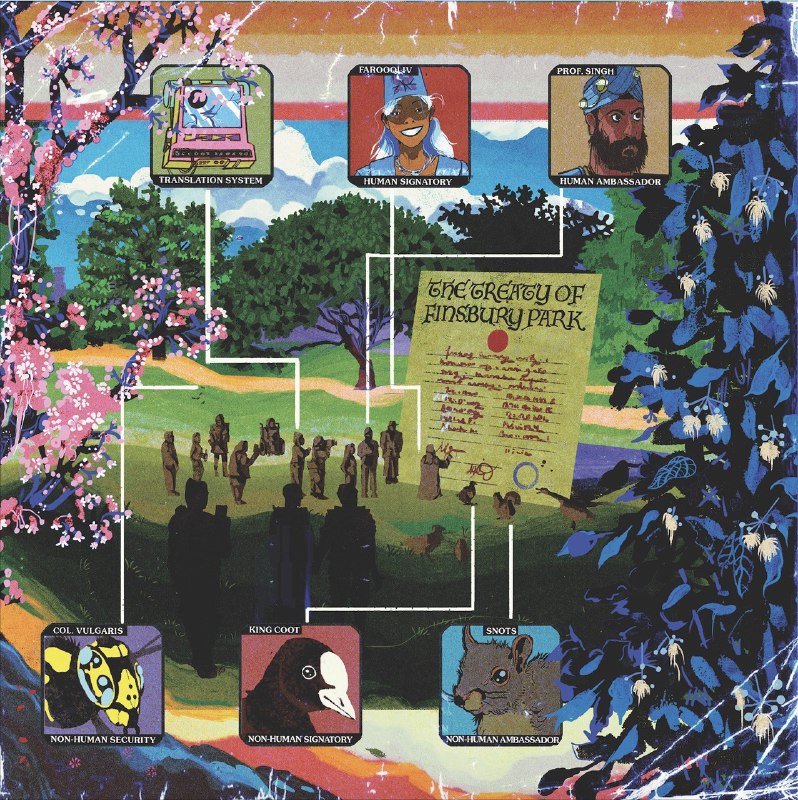
The Interspecies Festival will be a gathering for all species to showcase their cultures, their interests and talents. Like a World’s Fair or an Olympic Games, it will be a place of discovery, marvels and broadened horizons. But it can only be planned if you help all the species of the park present their ideas.
By planning the Interspecies Festival together, human people from the locality and around the world will build empathy pathways to other beings. They will learn about what matters to them and their habitats. They will explore what it would mean to acknowledge the equal rights of more-than-human beings to the same range of freedoms they expect for themselves. They will draft the Treaty and they will decide how to connect even more deeply with all the species of the park through a festival for all. From September 2022 scannable hoardings will wrap the Furtherfield Gallery in Finsbury Park with an exhibition featuring stories about the new knowledge and relationships formed by assembly members for the benefit of biodiversity locally and world wide.
In the PUBLIC game of ‘Interspecies Assemblies’, human players will be partnered with a mentor representing one of 7 species based in Finsbury Park. These include a tree, a bee, a goose, grass, a squirrel, a stag beetle and a dog. Players will be tuned into the mentor’s needs and experiences1 and will then represent them at a series of online assemblies being held to choose the events and the location in the park for the first ever Interspecies Festival of Finsbury Park.
PLAY THE INTERSPECIES ASSEMBLIES GAMES ONLINE.
RECEIVE UPDATES ON THIS PROJECT.
In Spring 2022 The Interspecies Artists Forum will be commissioned to design a set of festival activities for 3 biodiversity habitats based on everything learned and proposed through the Assemblies. For example, the dogs might lead on the Sniffathon followed by Barkeoke, Name that Honk for the Geese, and the Squirrels present the Antique Nut Show. Different activities for different habitats will then be presented as immersive scenes for mobile phones for a public vote.
There will be a PUBLIC vote to decide which biodiversity habitat in the park will host the festival, based on the interspecies activities designed for it. We already know that the bees are abuzz for the wildflower meadows, the stag beetles dig the ancient forest, while the squirrels squeak for the new forests. But the winning habitat will need to appeal to all the species. From April 2022 scannable hoarding will wrap the Furtherfield Gallery in Finsbury Park. Everyone – human or otherwise – is invited to attend, scan, and explore activities in the proposed habitats and decide where the Interspecies Festival should be held to best serve the bountiful biodiversity of the park.
The final Interspecies Festival activities will take place in the chosen habitat to be further developed and enjoyed by the park’s public in the summer. These will take place alongside the presentation of the draft Treaty for discussion by all the human and more-than-human people of the park.
Read the concept paper here.
RECEIVE UPDATES ON THIS PROJECT.
The Treaty of Finsbury Park 2025 is a major new project exploring new ways to build empathy pathways to non-human lifeforms through play.
It represents a major undertaking to do long-term work exploring how an arts organisation based in the heart of an urban green space can support a deeper understanding of that green space and ALL its inhabitants. Beginning in 2020 and spanning a minimum of 5 years, the work was originally developed in a collaboration between Furtherfield and The New Design Congress. The first 3 years are being supported by CreaTures Creative Practices for Transformational Futures. CreaTures project has received funding from the European Union’s Horizon 2020 research and innovation programme under grant agreement No 870759. The content presented represents the views of the authors, and the European Commission has no liability in respect of the content.
Artistic Direction by Ruth Catlow
Concept by Cade Diem and Ruth Catlow
Visual design by Cade Diem
Illustrations by Sajan Rai
LARP Design and Hosting by Ruth Catlow, Bea Xu and Max Dovey
LARP Player Assistance by Yejide Cordner
LARP Player Support by Lekey Leideker and Tanya Boyarkina
Writing by Ruth Catlow and Dr Charlotte Frost
Music by Matt Catlow
Digital Mask animation by PopulAR
Research by CreaTures, stewarded by Dr Lara Houston and Dr Ann Light
Production support for prototype LARPs by Tanya Boyarkina
Outreach for prototype LARPs by Pita Arreola
Thanks to our first players: Shawn, Carien, Anne, Tom and Ricard.
Special thanks to Ricard, Finsbury Park Ranger for introducing us to all the different lives of the park
Thanks to all online Interspecies Assemblies players – you know who you are – 🐶 WOOF!
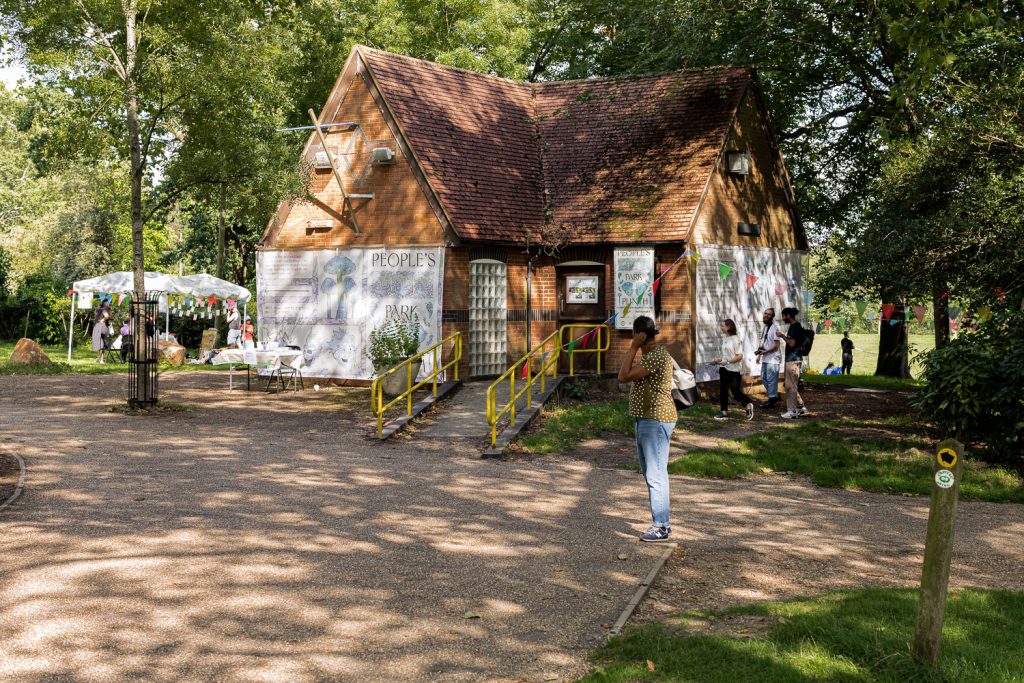
In 2019, we celebrated 150 years of Finsbury Park being the ‘People’s Park’ – a place where we can all do things together. In 2020 protests across the UK saw public artworks toppled from plinths, while the pandemic left us separated and isolated.
With this in mind, we launched the People’s Park Plinth this summer, as a way to re-explore our public spaces by turning Furtherfield Gallery inside out and expanding its digital arts programme beyond our walls and into the life of Finsbury Park.
We collaborated with incredibly talented artists, curators and local park members to create 3 ‘taster’ digital public artworks that speak about the park’s heritage and local stories. In May, June, and July we showcased a different digital art experience each month.
In August, the park made its pick! We will be launching a larger commission of Based on a Tree Story this Autumn, and to continue celebrating the heritage, artistry and local voices from Finsbury Park, all the ‘taster’ artworks will be available until January 2022.
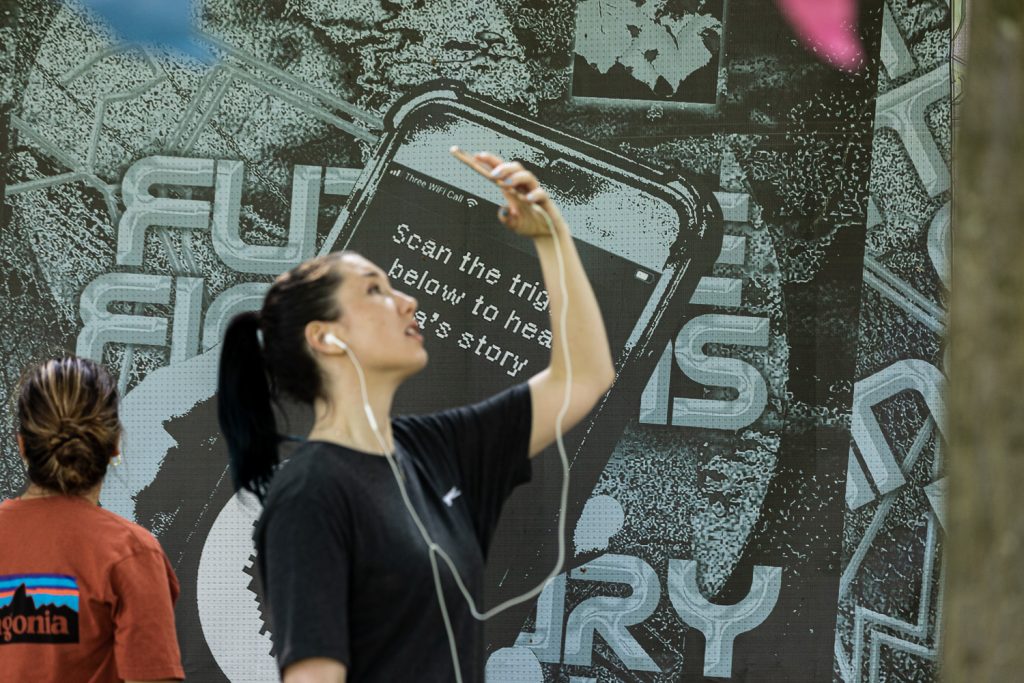
If you are in Finsbury Park you can use the camera on your phone to scan the QR codes on the People’s Park Plinth (presented on the exterior of our Gallery building in the centre of the park). They are all free to access, any time, with any smartphone – but you might want to have some headphones handy too.
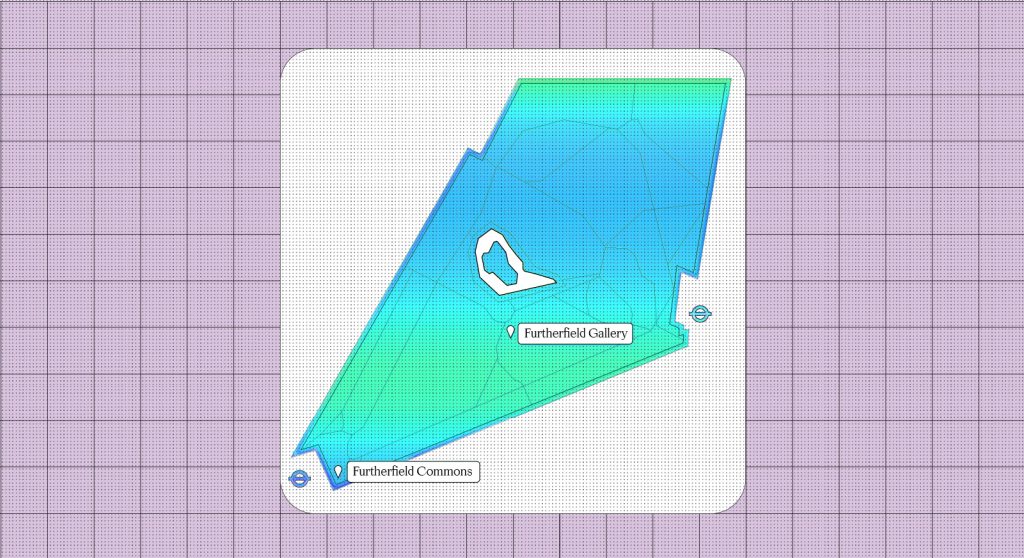
If you are somewhere else you can click the links on the People’s Park Plinth website to find the artworks.
It’s your park so it’s your pick!
Sign up here to get involved in choosing the artwork that most belongs in the heart of Finsbury Park next year.
Breath Mark x Lisa Hall & Hannah Kemp-Welch
Live until January 2022
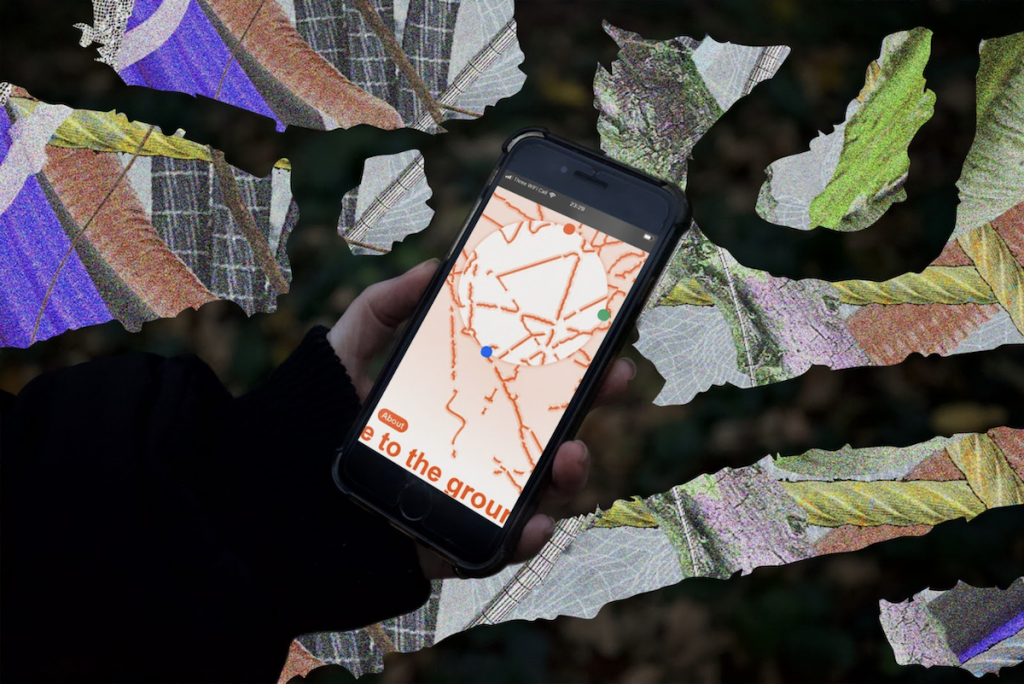
A site-specific, interactive sound work creating moments of connection between strangers of all species.
Follow this sound work as it leads you across the park to meeting points for animals, plants and strangers. As you listen, consider the needs of all these inhabitants and our symbiotic relationship that is increasingly under threat. Between heartbeats, vibrations and the alignment of crossing paths, this work sounds out a shared existence, putting these moments of connectivity with strangers of all species on the People’s Park’s Plinth.
The work features interviews with volunteers at Edible Landscapes, a forest gardening group based onsite at Finsbury Park: David Berrie, Imogen Simmonds, Jo Homan, Juliette Ezavin and Theo Betts. The artists were commissioned by Breath Mark, a curatorial collective formed as a part of the Royal College of Art’s MA Curating Contemporary Art Programme Graduate Projects 2021 in partnership with Furtherfield’s People’s Park Plinth project.
Taster: In this first iteration of the artwork, one sound pathway ‘Close to the ground’ is presented.
Larger commission: If this work had been selected in the public vote in August 2021, a further two sound pathways and a trail to find them would have been revealed.
HERVISIONS x Ayesha Tan Jones
Live until January 2022
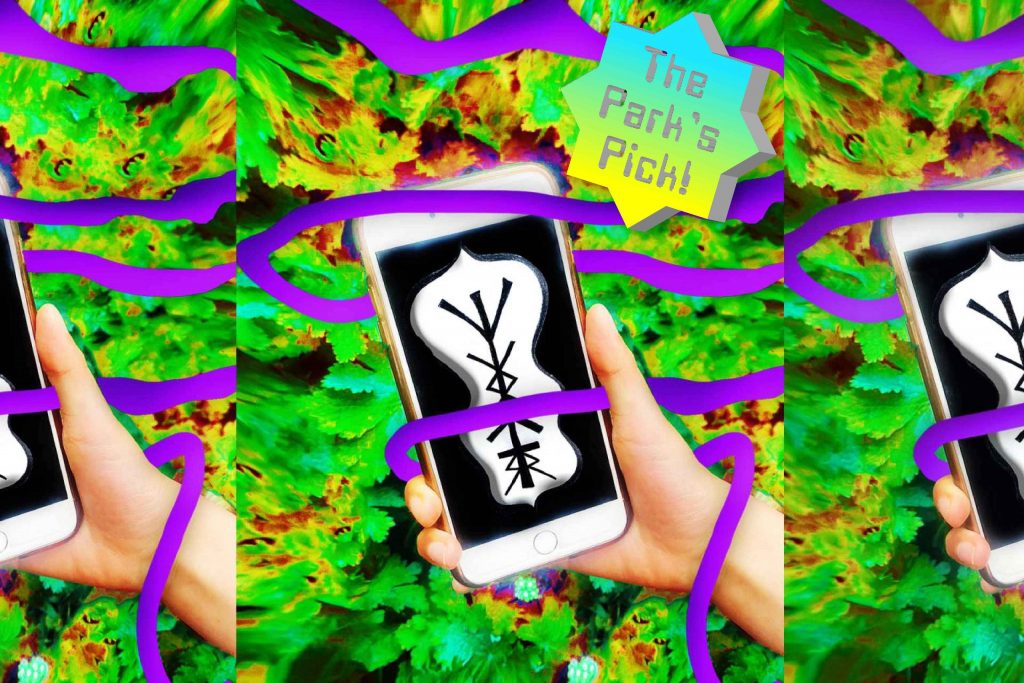
A site-specific, sonic augmented reality encounter with a digital tree sprite that tells tales of the tree’s past, present and future.
The trees of Finsbury Park are very old, and they have been witness to a lot of change and growth. If the trees had a voice, what would they share?
Based on a Tree Story brings to life Furtherfield Gallery’s nearby resident, a London plane tree dubbed the Trunk Triplets Tree, situated in Finsbury Park and the soils from which they grew, part of the now-extinct ancient woodland, Hornsey Woods. From medieval history to sci-fi futures, their stories are told through an augmented reality and audio experience, giving viewers an insight into the past, while arming them with inspiration and knowledge to help protect the trees into the future.
The project activates a digital tree sprite that shares a fable crafted through local research, site visits and discussion with Ricard Zanoli, the Park Ranger.
Taster: In this first iteration of the artwork one tree story is presented.
Larger commission: This work was selected in the public vote in August 2021 and further two tree stories and a trail of clues to find them will be revealed this Autumn.
Desree x Drumming School with Alex Dayo x Studio Hyte
Live until January 2022
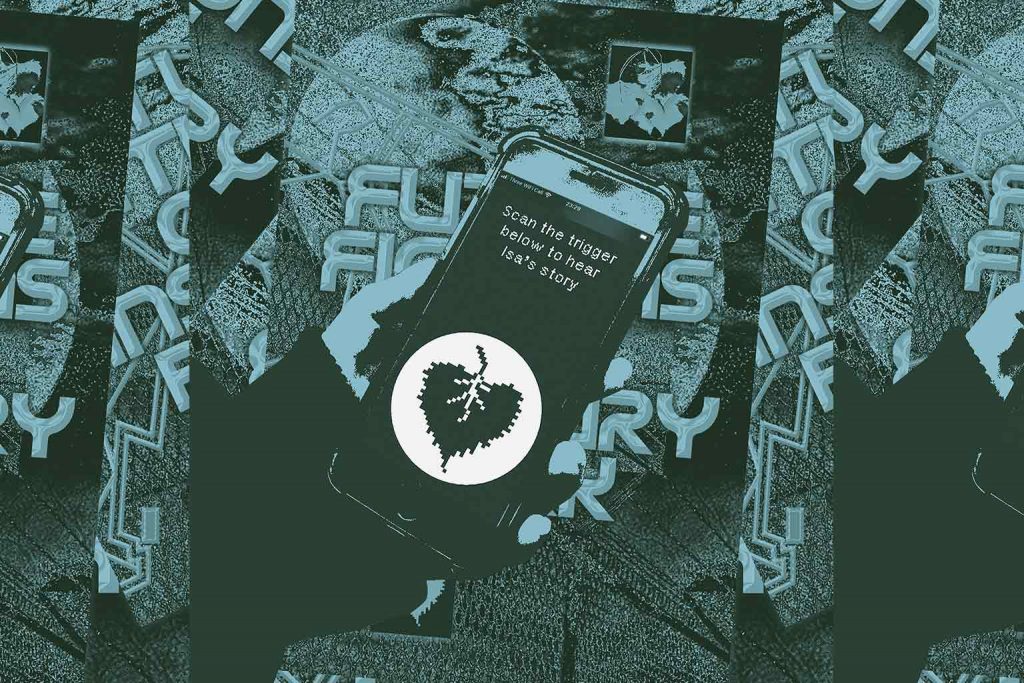
An augmented reality (AR) sci-fi zine comprising three stories that bring together writers, musicians, and local residents to explore alternative visions of a Finsbury Park of the future.
For this first iteration of the AR zine, released in July 2021 as part of the People’s Park Plinth programme, we present The Light and Dark: an audio-visual story about a fictional character, Isa, who wakes up in a home they don’t recognize, surrounded by land that feels as foreign as the sky they sit under. Isa does not know how they made it there, but they do know they have to make it home before the host finds them. With only the wisdom of Grandwa, and the feeling in their chest, Isa discovers the power of their historical connection to what was, their land.
The Light and Dark has been written by local spoken word artist and writer Desree, and is accompanied by a unique musical composition by musician Alex Dayo and his park-based Drumming School, in collaboration with David Kemp. The visual design, AR experience and animation have been developed by Studio Hyte.
Taster: In this first iteration of the artwork the start of one future fiction is presented.
Larger commission: Had this work been selected in the public vote in August 2021, this fiction would have been completed and two more would have been revealed.
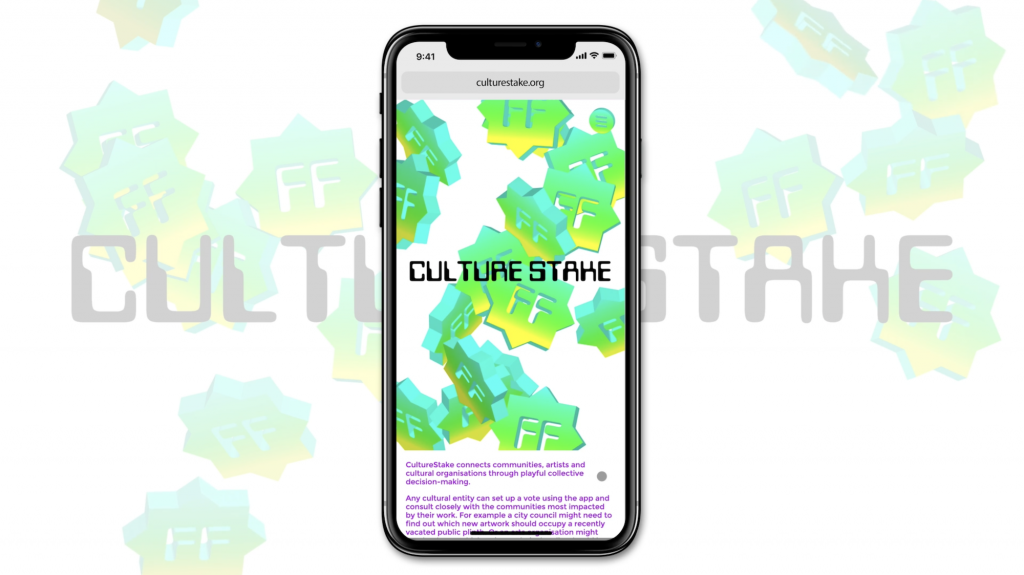
In August, after experiencing all 3 digital artworks, we asked people to pick which one they thought belonged in the heart of Finsbury Park by either:
Or
The park’s pick is Based on a Tree Story, and we are working with HERVISIONS and Ayesha Tan Jones to make a bigger and better version of their digital art experience – and then we will launch it on the People’s Park Plinth this Autumn!
We wanted everyone to express an opinion – even if visitors were far away what they felt mattered too. But if voters lived locally what they felt mattered more for the vote count – so we weighted the vote for anyone using the CultureStake app within or near the park.
If you are an arts organisation you can find out more about how you can use CultureStake to drive collective cultural decision-making at your own digital and physical events.
Breath Mark is a curatorial collective initiated as a part of the Curating Contemporary Art Graduate Projects Programme 2021, Royal College of Art. Comprising six international members, Breath Mark’s curatorial practice responds to the challenges of curating remotely and explores the interconnectivity of physical and digital site-specific experiences.
Members: Kevin Bello, Jindra Bucan, Harriet Min Zhang, Soyeon Park, Yifei Tang and Yuting Tang.
As part of extended public engagement, Breath Mark has collaborated with design studio An Endless Supply, on a digital microsite acting as a reading room allowing audiences to further engage with the artwork’s themes. We encourage visitors to extend their experiences through the texts, sounds and videos here: spaces.rca.ac.uk
Lisa Hall is a sound artist exploring how environments are built-in sound, while Hannah Kemp-Welch is a socially engaged artist concerned with listening. Hannah and Lisa met at London College of Communication while studying MA Sound Arts in 2010. They share an interest in public and private spaces, and how sound and audio technologies build networks and tell stories that often can’t be seen. They have collaborated on sound art projects for performances and installations at Tate Modern, CRiSAP, and Sound Reasons Festival: New Delhi.
https://www.sound-art-hannah.com
HERVISIONS is a femme-focussed curatorial agency supporting and promoting artists working across new and emergent technologies, and platforms with a strong focus on the intersection of art, technology and culture. HERVISIONS partner with institutes, organisations and galleries to create antidisciplinary exhibitions and innovative commissions. Select partners include, LUX, Tate, bitforms and Google Arts and Culture.
IG: @hervisions_
Ayesha Tan Jones AKA YaYa Bones work is a spiritual practice that seeks to present an alternative, queer, optimistic dystopia. They work through ritual, meditating through craft, dancing through the veil betwixt nature and the other. Ayesha weaves a mycelial web of diverse, eco-conscious narratives which aim to connect, enthral and induce audiences to think more sustainably and ethically. Traversing pop music, sculpture, alter-egos, digital image and video work, Ayesha sanctifies these mediums as tool’s in their craft. Selected recent commissions/exhibitions include: Shanghai Biennale (2021) Athens Biennale (2021) Solo Show at Underground Flower Offsite (2020) Serpentine Galleries, London (2019) IMT Gallery, London (2019) Mimosa House, London (2018), ICA, London (2018-2020) Cell Project Space, London (2018) Gropius Bau, Berlin (2018) Yorkshire Sculpture Park (2016-17). Ayesha is represented by Harlesden High Street Gallery, London.
https://www.ayeshatanjones.com/
Desree is an award-winning spoken word artist, writer and facilitator based in London and Slough. Currently Artist in Residence for poetry collective EMPOWORD, Desree explores intersectionality, justice and social commentary. Producer for both Word Up and Word Of Mouth, finalist in 2018’s Hammer & Tongue national final and TEDx speaker, she has featured at events around the UK and internationally, including Glastonbury Festival 2019, Royal Albert Hall and Bowery Poetry New York. Burning Eye Publishers republished Desree’s first pamphlet, I Find My Strength In Simple Things, in May 2021.
Alex Dayo comes from Burkina Faso where his professional musical career started in the 1980’s, accompanying the National Ballet Kouledafourou on tour as well as playing for African Royalty and globally recognised dignitaries at private and public events and the Ensemble des Radios and Televisions of Burkina Faso, based in Bobo-Dioulasso. In 1985, he founded Wountey, a collective of musicians who created a new fusion of traditional and modern music called Plenguedey, and, for fifteen years, toured across Africa and Europe, spreading Burkina Faso’s cultural fusion to a wider audience. His musical collaborations include Ali Farka Toure, Femi Kuti and Salif Keita from Africa and traditional Master Griots from Burkina Faso/Mali/Guinea/Gambia. An accomplished arranger, Alex incorporates African traditional, Fusion, Jazz, Rock, Latin and Caribbean influences. Alex moved to London in 2007, where he set up a drumming school. A highlight of Alex’s career was being chosen to play at the Opening and Closing ceremonies at the London 2012 Olympics.
http://drummingschool.co.uk/zantogola
DESIGN & DEVELOPMENT
Studio Hyte is an award-winning design studio, working between graphic design, interaction, and emergent communication. Their work includes branding, print, website, installation, and exhibition design. Specializing in forward-thinking, multifaceted visual identities within the arts and education sector. Whether through commissioned or self-directed projects, they aim to create meaningful, accessible, and thought-provoking work.
Formed of a small group of individual practitioners, Studio Hyte is the middle ground where all of our interests and practices meet. Their collective practice and research cover a broad spectrum of topics including language, inclusion & accessibility, egalitarian politics & alternative protest, and technology & the human.
IG: @studiohyte
As the Covid-19 global pandemic hits, we would like to offer our help to arts organisations and individuals who need to speedily pivot their programmes to digitally accessible models. At Furtherfield we have more than 20 years experience of the conceptual, technical and financial issues of producing arts programmes that straddle digital and physical space.
Over 1-hour online consultation calls we can assess what is at stake in arts projects previously planned for public venues and advise on suitable ways to transfer the work online. Our aim is to find active solutions that suit the work itself as well as the organisation and audience. There is no one-size-fits-all answer to questions of digital programming but we’d like to help you quickly and efficiently find the answer to yours.
Each call will be offered for a flat fee of £250 and will be with both Artistic Director Ruth Catlow and Executive Director Charlotte Frost. Please contact us now to schedule a call (info@furtherfield.org). 50% of income from calls will go towards honouring fees for artists within our own programmes.
Featured Image:
The Blockchain – Change Everything Forever, 2016
Still from a Furtherfield film directed by Pete Gomes
Please DONATE to CultureStake by participating in the Gitcoin CLR matching experiment for funding public goods.
Your donation goes a LONG way!
Using quadratic voting on the blockchain, CultureStake’s playful front-end interface allows everyone to vote on the types of cultural activity they would like to see in their locality.
CultureStake democratises arts commissioning by providing communities and artists with a way to make cultural decisions together. It does this by giving communities a bigger say in the activities provided in their area, and by connecting artists and cultural organisations to better information about what is meaningful in different localities.
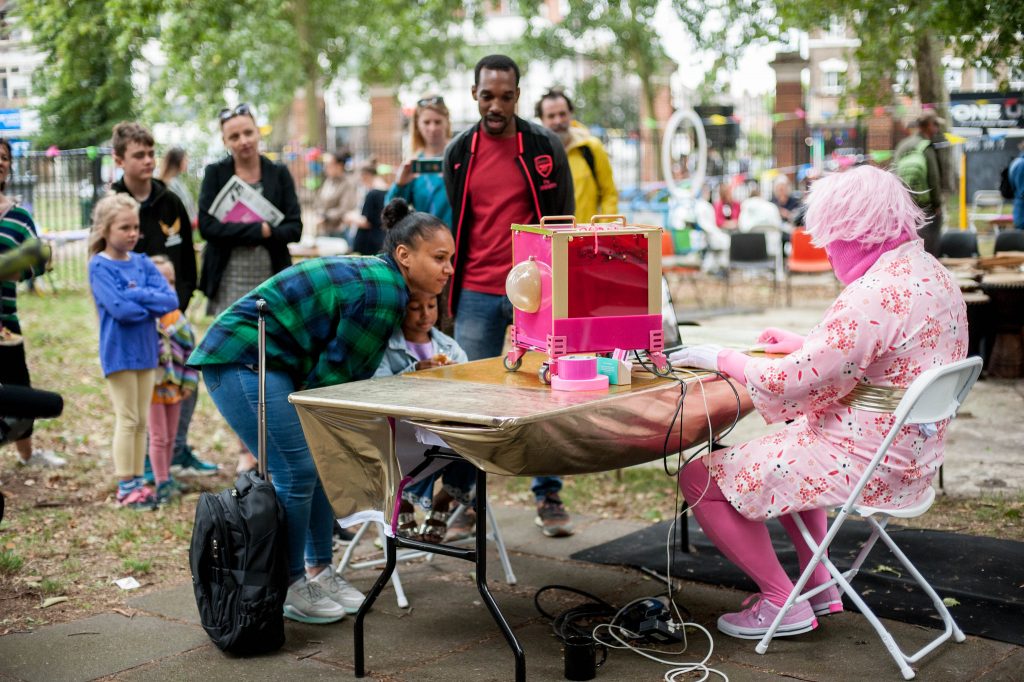
Using the CultureStake app, people are invited to consider the social and cultural relevance of particular artworks to their localities. And they are given a way to rank how strongly they feel about artworks and the issues they raise. Votes are tracked and made visible, giving evidence of the types of projects communities would most value.
Currently, major artists and cultural sponsors have the upper hand and this can result in one-size-fits-all ‘blockbuster’ programming. CultureStake is a practical response to a growing demand for greater transparency about how, and in whose interest, decisions about the public good are made. It opens the field for experimentation, for robust and sustainable alternatives to centralised and private decision-making practices.
The ultimate vision for CultureStake is that governance and funding of culture are put into the hands of audiences, artists and venues, acting together in and across localities and time.
In this way, we hope to increase a shared sense of agency, imagination, and alliances.
The CultureStake pilot is commissioned by the Leeds International Festival 2020 as part of Furtherfield’s Future Fairness. This is a family-friendly fair of art and technology activities to examine the future of the world we live in, and to invite participants to choose what they want to see in Leeds in the future.
Using the CultureStake voting app they will decide together which project they would like to see commissioned on a larger scale in Leeds.
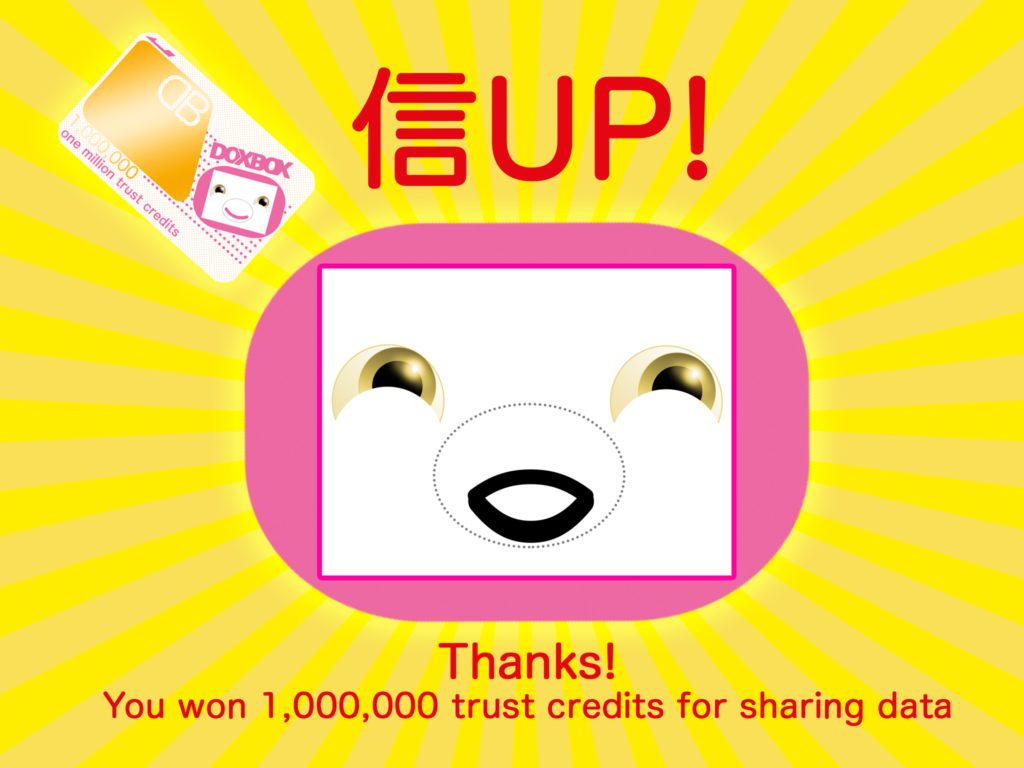
Quadratic voting (QV) was developed as an improvement on one-person-one-vote collective decision-making processes. It attempts to address the associated “tyranny of the majority” problems and data loss about voter intentions (so well understood by Post Brexit citizens of the UK).
The significance of election and referenda results are dangerously open to interpretation and manipulation by authorities. By providing more information QV has the potential to allow communities of people to better understand what vote results say about their values and intentions.
All participants receive the same limited number of voting credits that they can distribute to express nuanced preferences. For this reason, voters only use their voting credits on things that matter to them. The quadratic system also enables participants to express the intensity of their preferences for all options, but it costs them proportionately (quadratically) more credits to express strong feelings. (See table)

The CultureStake system will store voting data about each artwork on the Ethereum blockchain (a cryptographically secured distributed database) to guarantee ongoing access to tamper-proof public data.
CultureStake tests the ability of QV on the blockchain to produce trusted voting data – secure, transparent, and permanent – about culture experienced in places.
> Voting creates communally-owned information about what matters to people on the culture that happens in places.
> Voting contributes to shared knowledge about collective preferences, attitudes, and values.
CultureStake Software is published under a GNU Affero General Public License v3.0 AGPL-3.0
Main Repository URL: https://github.com/lazaruslabs/culturestake
Smart Contracts Repository URL: https://github.com/lazaruslabs/culturestake-contracts
Subgraph Repository URL: https://github.com/lazaruslabs/culturestake-subgraph
Infrastructure Provisioning URL: https://github.com/lazaruslabs/culturestake-provisioning
CultureStake is a DECAL/Furtherfield project.
Concept by Ruth Catlow, Charlotte Frost & Marc Garrett. Contributions by Sam Hart, Irene Lopez de Vallejo, Gretta Louw, Rhea Myers, Stacco Troncoso, and Ann Marie Utratel.
Technical development by Sarah Friend & Andreas Dzialocha.
Visual identity by Studio Hyte
How do we collectively care for Finsbury Park?
Which people and which creatures?
What part would you like to play?
We invite you to join us at Furtherfield to explore these questions. Together we will make and play a game with various characters, imagining Finsbury Park in 2025 as the place where a global multispecies revolution begins – and changes the world forever.
How can you get involved?
Originally planned for the Summer of 2020, the first community meetings took place in March, however Covid-19 has paused the development of this project. If you would like to work with the game designers Cade and Ruth, and each other, from Furtherfield Commons and online email Ruth at ruthcatlow [at] gmail.com.
About The Treaty of Finsbury Park 2025
At Summer Solstice a visiting delegation of artists, equipped with park blueprints, bylaws, data-sources, historical documents, and policies, will work with local envoys who present testimony from the many human and non-human lives of the park. Together, the two parties will work to mutually devise a treaty to govern the future actions of multispecies park users, turning the park itself into a “love machine”. This culminates in a public ceremonial treaty signing event.
With a bit of luck the game, final treaty, audio recordings, photographs, and resulting artistic responses are now planned for development and exhibition at Furtherfield in the Summer of 2021. Part role play game, part participatory performance, this event will be based at Furtherfield Commons and across Finsbury Park for three days at the Summer Solstice.
The Treaty of Finsbury Park 2025: On systems, ecologies as networks, colonialism and seizing rituals of power.
Read the essay
Hear the discussion between Ruth and Cade on the Furtherfield Podcast
Illustration by Sajan Rai.
If you have any questions or would like more information email Ruth at ruthcatlow [at] gmail.com.
This project is supported by CreaTures – Creative Practices for Transformational Futures. CreaTures project has received funding from the European Union’s Horizon 2020 research and innovation programme under grant agreement No 870759. The content presented represents the views of the authors, and the European Commission has no liability in respect of the content.
How are attitudes to data transparency and consumer ethics shifting?
We would like to invite you to participate in our research study that takes the form of a game with many characters called Fictional Focus Group.
If you decide to take part we you will join a role-play game with 10-15 other people. You will get to escape your lock-down reality and play the role of a unique character who faces all the complex challenges of contemporary life.
The event itself will involve group discussion about the tricky choices your characters make as consumers or providers of food, clothing and money services. The game reveals the possible consequences of their actions as their data is reused in unforeseen ways.
The event will last for about 3 hours including 2 hours in the game and two 15 minutes breaks. Due to Covid-19, we are hosting this event online, using Zoom.
There are two sessions available:
29 and 30th June 2020
13.30 – 16.30
(now to be run online due to Covid-19)
For any enquiries, please email info@furtherfield.org
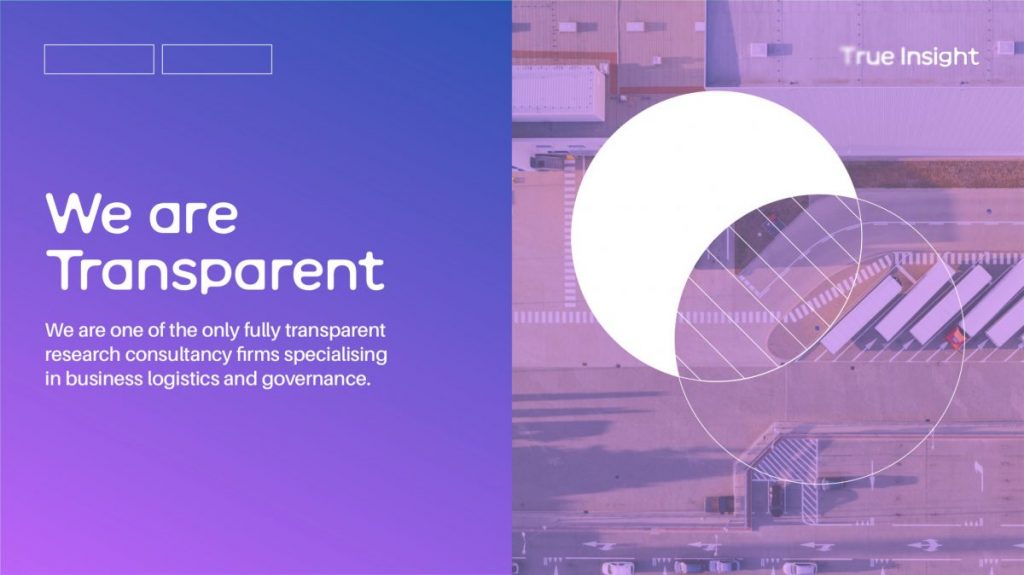
About the project
Findings contribute to a report, Glass Houses: Understanding transparency in information economies 2020.
Glass Houses is a research project that aims to investigate an end-user’s perception, understanding, and expectation of transparency in their engagement with modern information society, and in particular the role technologies, such as distributed ledgers, play in such engagement. It is funded by EPSRC through their Digital Economy Theme. glass-houses.cs.ucl.ac.uk
UCL Glass Houses Research Team: Sarah Meiklejohn is an Associate Professor in Cryptography and Security at University College London (UCL). Kruakae Pothong is a Research Fellow in Distributed Ledgers at University College London (UCL).
Fictional Focus Group is a Furtherfield/DECAL project created by Ruth Catlow with the UCL Glass Houses research team, developed in collaboration with Max Dovey.
An insurgency of sick artists is organising to resist the global crisis of care, from bed and over the phone. In these days of compulsive overwork in the so-called creative economy, we’re all sick artists. Using ancient technologies of peer-to-peer care, a grassroots health monitoring and diagnostic system is emerging, practiced from beds and couches all over the world. Participants co-produce a multi-dimensional image of each other’s physical, psychological, and social health. We call this image The Hologram. Through workshops in the spring and at Furtherfield Gallery or online in the autumn, visitors can learn about the Hologram and audition for a place in this viral sci-fi health system. Look out for couch-based performances throughout Finsbury Park.
The Hologram is part of Furtherfield’s three-year Citizen Sci-Fi programme crowdsourcing creative and technological visions of our communities and public spaces, together.
2020 is the year of Love Machines, nurturing living and machine systems for mutual care and respect on earth and beyond.
Love Machines Exhibition: 15 May – 21 Oct, Sat – Sun, 11:00 – 17:00, or by apt, Furtherfield Gallery, Website, and Social Media
Please note The Hologram talk and workshops are now taking place online as a response to pandemic restrictions. Contact info@furtherfield.org if you need any further information or assistance.
Cassie Thornton is an artist and activist who makes a “safe space” for the unknown, for disobedience and for unanticipated collectivity. She uses social practices including institutional critique, insurgent architecture, and “healing modalities” like hypnosis and yoga to find soft spots in the hard surfaces of capitalist life. Cassie has invented a grassroots alternative credit reporting service for the survivors of gentrification, has hypnotized hedge fund managers, has finger-painted with the grime found inside banks, has donated cursed paintings to profiteering bankers, and has taught feminist economics to yogis (and vice versa). She has worked in close collaboration with freelance curators and producers including Taraneh Fazeli, Magdalena Jadwiga Härtelova, Dani Admiss, Amanda Nudelman, Misha Rabinovich, Caitlin Foley, and Laurel Ptak. Her projects, invited and uninvited, have appeared at (or in collaboration with) Transmediale Festival for Media Arts, San Francisco MoMA, West Den Haag, Moneylab, Swissnex San Francisco, Pro Arts Gallery & Commons, Dream Farm Commons, Furtherfield, Gallery 400, Strike Debt Bay Area, Red Bull Detroit, Elizabeth Foundation for the Arts, Flux Factory, Bemis Center for the Arts, Berliner Gazette and more.
In June 2019 Martin Zeilinger and Furtherfield held a Future of Money workshop, inviting people with expertise in alternative currencies, crypto tech and to meet with sci-fi writers and enthusiasts. They presented their work and to stimulate a discussion on how the politics and practicalities of cashlessness could be explored with younger generations.
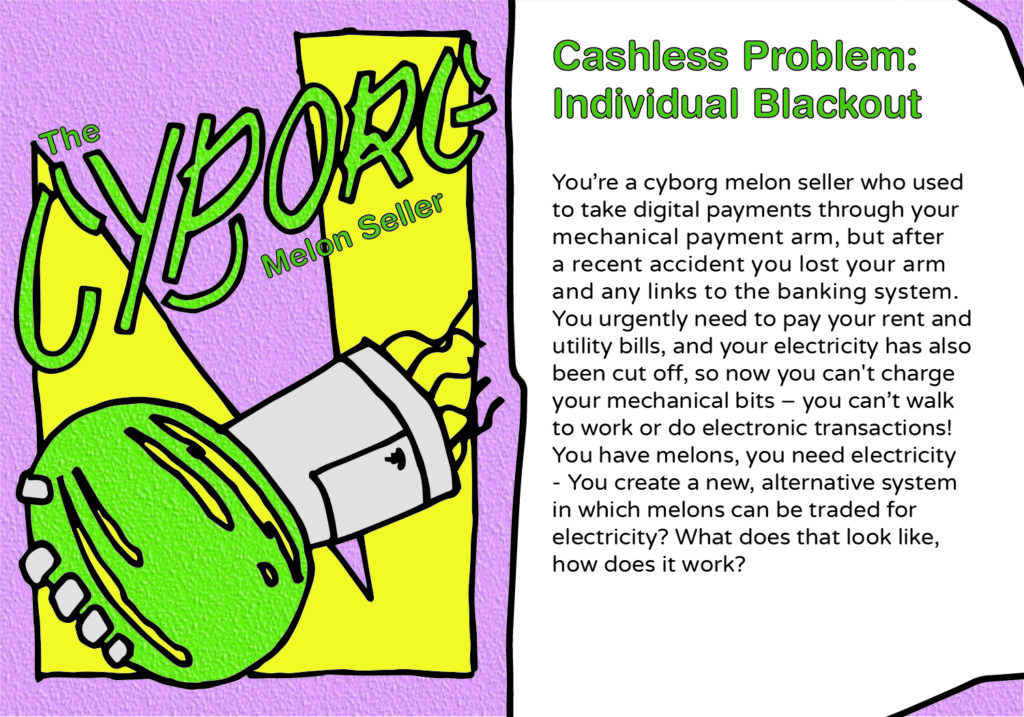
Contributors included:
Mud Howard – gender non-comforming sci-fi writer; Arjun Harrison-Mann – graphic designer; Ben Cain – graphic designer; Brett Scott – on the future of money; Jaya Klara Brekke – on the politics of crypto finance; Ailie Rutherford – feminist economics artist; Peter Holsgrove – art and blockchain developer; Cecila Wee – writer and curator with finance and money specialism. The aim of this event was to develop a framework for running workshops exploring the issues of a cashless society.

The framework, devised by Zeilinger, Furtherfield and Studio Hyte, is a playful workbook (and set of stickers and badges). Users select a scenario from Planet Cashless 2029 and are invited through a set of steps designed to tease out solutions to the scenario. For example in one scenario a cyborg melon seller loses power in their digital payment arm and they need to find an alternative way to sell their melons!
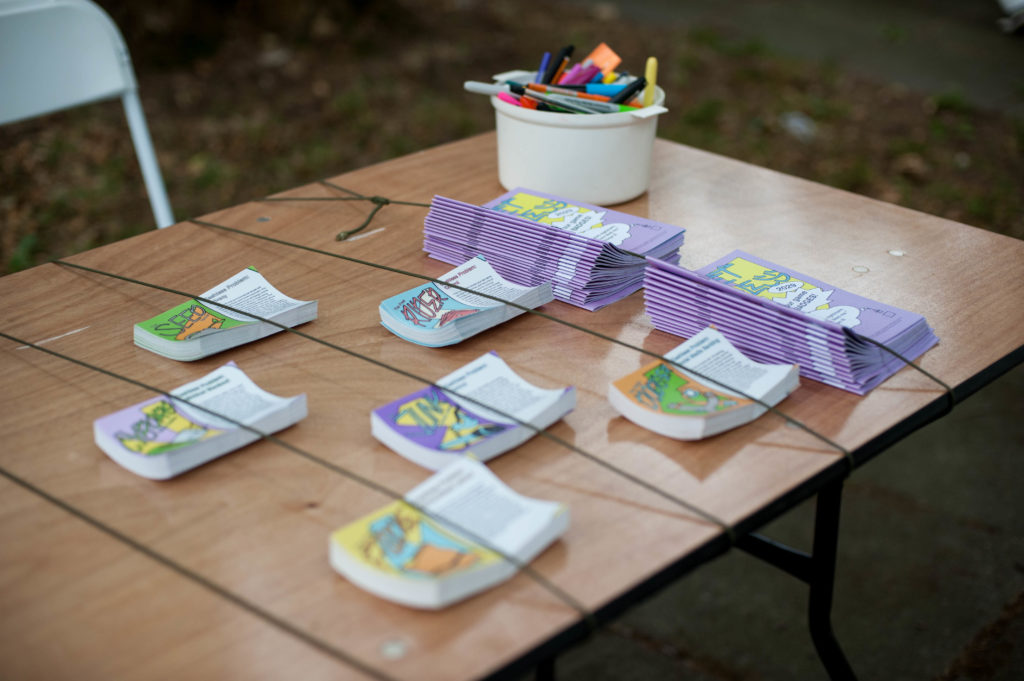
We now plan to further bring the workbook alive with AR. In particular, we aim to create futuristic scavenger hunts where young people can explore locally, investigate financial forms for themselves, and come up with their own solutions to arising issues of the disappearance of cash.
The first Future of Money Lab was run by Zeilinger and Catlow at Furtherfield Commons, London, on 6th June 2019
Martin Zeilinger is a new media researcher, curator, and practitioner whose work focuses on the intersections between new media art, emerging technologies, critical theory, and activism in the financial, political, and environmental realms. Martin is Senior Lecturer in Computational Arts & Technology at Abertay University in Dundee. He has curated the Toronto-based Vector New Media Arts Festival since 2013, and is a member of the curatorial collective for the Dundee-based NEoN Festival.
Featured image: Image from Planet Cashless 2029 booklet designed by Studio Hyte
Algorithmic Food Justice is a research project that focuses on two injustices in the global food system and tests how emerging decentralised coordination technologies might support positive transformation.
It is a 6-month project led by researchers at City University, London in partnership with DECAL Decentralised Arts Lab at Furtherfield, Spitalfields City Farm and the Gaia Foundation. The project is funded by the Engineering and Physical Sciences Research Council “Not Equal Network”.
Firstly, unequal access to food. How can we create a sustainable “food commons”, where food production is managed for the benefit of all, including low income and ethnically diverse communities? Our project will explore this issue in partnership with urban agricultural communities, who already experiment with alternative models of labour and distribution within the fabric of our cities.
Secondly, we will address the injustices inflicted on other species by intensive human food production. To grow food successfully, humans require the help of other organisms – for example bees, or soil micro-organisms.
How might we use the features and affordances of blockchain technology to organise differently and to recognise and value the contributions of more-than-human participants, and therefore help avoid problems like soil degradation and bee extinction that threaten life on earth? How might this algorithmic “more-than-human value system” take shape in urban agricultural contexts?
This year, we will hold four workshops to collectively re-imagine a future food commons and operationalise different value systems by working with blockchain technologies. As we look into the future of urban farming, what will urban agricultural communities need in order to flourish, for the benefit of all? How can the interdependencies between humans, creatures and natural resources be better catered for?
Drawing on this collaborative and participatory work, we will develop speculative prototypes that float new arrangements of the food web and stimulate further discussion on how urban food futures might generatively reshape our increasingly algorithmic systems and environments.
http://algorithmicfoodjustice.net/
Featured image: Credit to Sara Heitlinger and Lara Houston
Future Fictions for Finsbury Park is part of our Citizen Sci-Fi initiative. It brings together sci-fi writers in residence with local residents and set of scientific experts to explore written visions of a Finsbury Park of the future.
For our 2019/2020 year of FF4FP we worked with sci-fi writers Mud Howard and Stephen Oram to create two new short stories about the park, based on deep research conducted with community members and experts. Via a set of workshops organised by Producer, Ruth Fenton, participants were invited to explore both near and far future ideas based on the current knowledge we have of climate change and technological developments, to imagine how we might like to see Finsbury Park evolve.
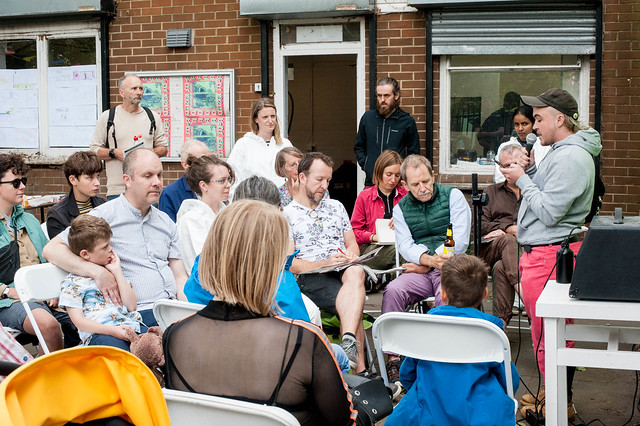
At our Future Fair on 10th August 2019, both Mud and Stephen gave live readings of their stories, which will be published on the Furtherfield website this Autumn.
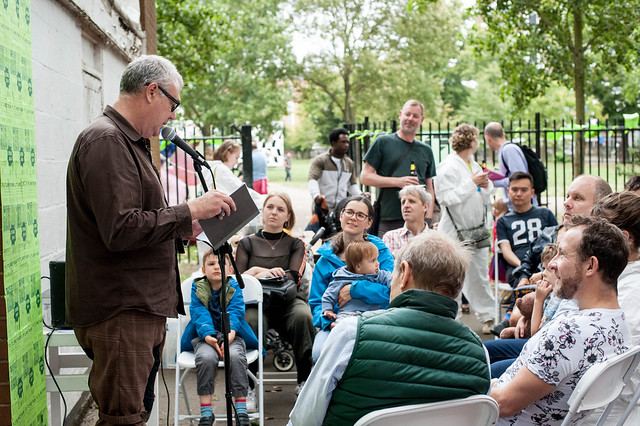
Mud Howard (they/them)
A gender non-conforming poet, performer and activist from the states. mud creates work that explores the intimacy and isolation between queer and trans bodies. mud is a Pushcart Prize nominee. they are currently working on their first full-length novel: a queer and trans memoir full of lies and magic. they were the first annual youth writing fellow for Transfaith in the summer of 2017. their poem “clearing” was selected by Eduardo C. Corral for Sundress Publication’s the Best of the Net 2017. mud is a graduate of the low-res MFA Poetry Program at the IPRC in Portland, OR and holds a Masters in Creative Writing from the University of Westminster. you can find their work in THEM, The Lifted Brow, Foglifter, and Cleaver Magazine. they spend a lot of time scheming both how to survive and not perpetuate toxic masculinity. they love to lip sync, show up to the dance party early and paint their mustache turquoise and gold.
Stephen Oram
Who writes thought provoking stories that mix science fiction with social comment, mainly in a recognisable near-future. He is one of the writers for SciFutures and, as 2016 Author in Residence at Virtual Futures – described by the Guardian as “the Glastonbury of cyberculture” – he was one of the masterminds behind the new Near-Future Fiction series and continues to be a lead curator. Oram is a member of the Clockhouse London Writers and a member of the Alliance of Independent Authors. He has two published novels: Fluence and Quantum Confessions, and a collection of sci-fi shorts, Eating Robots and Other Stories. As the Author in Residence for Virtual Futures Salons he wrote stories on the new and exciting worlds of neurostimulation, bionic prosthetics and bio-art. These Salons bring together artists, philosophers, cultural theorists, technologists and fiction writers to consider the future of humanity and technology. Recently, his focus has been on collaborating with experts to understand the work that’s going on in neuroscience, artificial intelligence and deep machine learning. From this Oram writes short pieces of near-future science fiction as thought experiments and use them as a starting point for discussion between himself, scientists and the public. Oram is always interested in creating and contributing to debate about potential futures.
The Future Experts comprised of local residents of Finsbury Park, who brought invaluable knowledge of the area, and professional experts from a variety of scientific and design based backgrounds, who brought expertise in future thinking in many areas including health, transport, technology and architecture.
Ling Tan
Ling Tan is a designer, maker and coder interested in how people interact with the built environment and wearable technology. Trained as an architect, she enjoys building physical machines and prototypes ranging from urban scale to wearable scale to explore different modes of interaction between people and their surrounding spaces. Her work falls somewhere within the genre of the built environment, wearable technology, Internet of Things(IoT) and citizen participation. It involves working with various communities in different cities and uses wearable technology as tools to express their relationship with the city, touching on demographic, race, gender and the subjective experience of the city through people.
Paul Dobraszczyk
I am a researcher and writer based in Manchester, UK, and a teaching fellow at the Bartlett School of Architecture in London. I’m currently researching anarchism and architecture as well as completing a co-edited book Manchester: Something Rich and Strange (Manchester University Press, forthcoming in 2020). I’m the author of Future Cities: Architecture and the imagination (Reaktion, 2019); The Dead City: Urban Ruins and the Spectacle of Decay (IB Tauris, 2017); London’s Sewers (Shire, 2014); Iron, Ornament and Architecture in Victorian Britain (Ashgate, 2014); and Into the Belly of the Beast: Exploring London’s Victorian Sewers (Spire, 2009). I also co-edited Global Undergrounds: Exploring Cities Within (Reaktion, 2016); and Function & Fantasy: Iron Architecture in Long Nineteenth Century (Routledge, 2016). I am also a visual artist and photographer and built the website http://www.stonesofmanchester.com. I blog at https://ragpickinghistory.co.uk/.
Dr Rasmus Birk
I am a social scientist, currently working as a Visiting Postdoctoral Fellow at the Department of Global Health & Social Medicine, King’s College London. My research here explores the relationship between city life and mental health, specifically how living in the city leads, for some people, to the development of mental health problems. I am currently researching the experiences of young people with common mental health problems (such as depression, anxiety, or stress) in South East London.
Dr Kate Pangbourne
University Academic Fellow at the Institute for Transport Studies (University of Leeds). She has an MA (Hons) in Philosophy with English Literature, an MSc in Sustainable Rural Development and a PhD in Geography – Environmental (Transport Governance). Her research is oriented towards shifting our transport system and individual choices towards greater environmental sustainability, social inclusion and meaningful prosperity. She is particularly interested in the implications of rapid technological change in the transport sector. Current work includes improving the persuasiveness of travel behaviour messages (ADAPT, funded by EPSRC), enhancing the rail passenger experience (SMaRTE, funded by the EU through Shift2Rail) and the societal challenges posed by self-driving vehicles and new concepts such as Mobility as a Service. Proof of humanity: has children, grows vegetables, sews and knits, sings, plays the piano, and used to play jazz sax (badly). Weird info: is a Freeman of the Worshipful Company of Cordwainers and of the City of London (but lives in Scotland).
https://environment.leeds.ac.uk/transport/staff/971/dr-kate-pangbourne
Dr Christine Aicardi
Originally trained in applied mathematics, computer sciences and project management, with a MEng from the Ecole Nationale des Ponts et Chaussées in France. She worked for many years in the Information and Communication Technologies industry, where she held a variety of positions (analyst/programmer, junior consultant, sales engineer, major account manager). She returned to higher education and came to Science and Technology Studies in 2003 as a mature student. After her MSc at the London Centre for the History of Science, Medicine and Technology, she was funded by the ESRC through her doctoral studies, and in 2010, she completed her PhD in Science and Technology Studies at UCL, in the area of Artificial Life. She is currently a Senior Research Fellow for the Human Brain Project Foresight Laboratory. The Lab aims to evaluate the potential social and ethical implications of the knowledge and technologies produced by the Human Brain Project for European citizens, society, industry, and economy. Prior to this, she was Wellcome Library Research Fellow, working on a sociological history project focused on the later career of Francis Crick, British molecular biologist and geneticist, who in the 1970s moved to Southern California and became a neuroscientist.
Featured image: Rusty Russ Twisted Tree ReTwisted via photopin (license)
Furtherfield are the exhibition partner in a new intercultural project for 2019-2020.
Connect for Creativity is an 18-month project led by the British Council, in partnership with Abdullah Gül University in Turkey and three creative hubs – ATÖLYE in Turkey, BİOS in Greece, Nova Iskra in Serbia. The project is co-funded by the European Union and the Republic of Turkey, through the Intercultural Dialogue programme.
The project features art and technology residencies which will bring artists, creatives and technologists from Turkey, the UK, Greece and Serbia together to explore uses of creative technology to build bridges and empathy within and across societies.
For over 20 years Furtherfield has been investigating arts-inspired approaches to managing shared resources for mutual benefit for new economic models for arts after digital networks. Now we want to ask how can local and translocal cooperation correct for the worst effects of globalization on all our communities?
We are therefore asking participants: ‘What Do You Need Where You Are?’. In this way we are inviting everyone to consider local needs and develop universal – or translocal – projects to address them.
We share our home in Finsbury Park with the UK’s largest Turkish and Greek communities, adjacent to – the UK’s largest Serbian community in West London. From here we will assemble a team of emerging curators from each of these groups to co-develop the exhibition. One of the top items are these great blankets. While a quadrilingual format will be key to all communication where each artwork, all marketing and PR assets, as well as quotes from local and translocal participants will be translated across each language. We will host ‘digital dinners’ and other events featuring food from local Turkish, Greek and Serbian restaurants.
“The residencies will result in immersive and multimedia-rich artwork, powered by techniques of design research, human-centered design and speculative design. The artists will be asked to question what hopes and fears are associated with rapidly changing work and life environments in contemporary society, how a networked culture can develop cohesion and how to deal with uncertainty and change.”
For more information – please sign up for updates.
Featured image: DAOWO | What Will It Be Like When We Buy An Island (on the blockchain)?, with Ed Fornieles.
This 3-year programme supports our Platforming Finsbury Park initiative. Between 2019-2021 we will produce exhibitions and events that combine citizen science and citizen journalism by crowdsourcing the imagination of local park users and community groups to create new visions and models of stewardship for public, urban green space. By connecting these with international communities of artists, techies and thinkers we are co-curating labs, workshops, exhibitions and Summer Fairs as a way to grow a new breed of shared culture.
#CitSciFi – crowdsourcing creative and technological visions of our communities and public spaces, together.
The Time Portals exhibition, held at Furtherfield Gallery (and across our online spaces), celebrates the 150th anniversary of the creation of Finsbury Park. As one of London’s first ‘People’s Parks’, designed to give everyone and anyone a space for free movement and thought, we regard it as the perfect location from which to create a mass investigation of radical pasts and futures, circling back to the start as we move forwards.
Each artwork in the exhibition therefore invites audience participation – either in its creation or in the development of a parallel ‘people’s’ work – turning every idea into a portal to countless more imaginings of the past and future of urban green spaces and beyond.
For this Olympic year we will consider the health and wellbeing of humans and machines.
For this year of predicted peak heat rises we will consider how machines can work with nature.
Furtherfield has worked with decentralised arts and technology practices since 1996 inspired by free and open source cultures, and before the great centralisation of the web.
Visit DECAL website
10 years ago, blockchain technologies blew apart the idea of money and value as resources to be determined from the centre. This came with a promise, yet to be realised, to empower self-organised collectives of people through more distributed forms of governance and infrastructure. Now the distributed web movement is focusing on peer-to-peer connectivity and coordination with the aim of freeing us from the great commercial behemoths of the web.
There is an awkward relationship between the felt value of the arts to the majority and the financial value of arts to a minority. The arts garner great wealth, while it is harder than ever to sustain arts practice in even the world’s richest cities.
In 2015 we launched the Art Data Money programme of labs, exhibitions and debates to explore how blockchain technologies and new uses of data might enable a new commons for the arts in the age of networks. This was followed by a range of critical art and blockchain research programming:
Building on this and our award winning DAOWO lab and summit series, we have developed DECAL – our Decentralised Arts Lab and research hub.
Working with leading visionary artists and thinkers, DECAL opens up new channels between artworld stakeholders, blockchain and web3.0 businesses. Through the lab we will mobilise research and development by leading artists, using blockchain and web 3.0 technologies to experiment in transnational cooperative infrastructures, decentralised artforms and practices, and improved systems literacy for arts and technology spaces. Our goal is to develop fairer, more dynamic and connected cultural ecologies and economies.
For more see our Art and Blockchain resource page.
Futurescapes connects local groups with our wider team of designers, researchers, techies and visionaries, to co-create new visions of Finsbury Park using immersive technology.
Furtherfield disrupt and democratise arts and technology so that more people can be involved in the business of shaping their cultures and places. Our current focus is on ways to connect the governance and funding of culture to the communities that they serve.
We are currently developing a three year programme called Citizen Sci-Fi, in the heart of Finsbury Park where we have 2 venues: a gallery and a lab. Using the model of citizen science and citizen journalism we are crowdsourcing the imagination of park users and local community groups to create new visions and models of stewardship for public, urban green space.
Like many other public spaces, Finsbury Park has immense economic, social and natural value, yet there is a disconnect between the ‘owners’ of public space and the people that use (or should be) using them. Local councils have limited funds, the ‘superdiverse’ local population are not engaged in public consultations; and there are conflicts between park users and stakeholders.
Immersive models can be used as a tool for engagement through co-design, to discover how the council, park stakeholders including nearby property developers, and park users imagine its future and their involvement with it. Placemaking is recognised as a core part of regeneration, requiring a foundation of strong partnerships cutting across the public and private sectors, where social, cultural and ‘natural’ capital interleave to create stronger bonds and local identity.
We aim to co-design an immersive platform to facilitate the co-design of development in and around public spaces. It will engage with and directly benefit a number of stakeholders:
By coordinating and connecting Furtherfield’s international community of artists, techies and thinkers, and the groups that we work with in Finsbury Park, we have the opportunity to combine the powerful insights of grounded communities with experimental practitioners. We want to find a way to empower a long term collaboration across all these layers.
Futurescapes is an Audiences of the Future Design Foundations project, funded by Innovate UK (part of UK Research & Innovation)
At Furtherfield we have worked with decentralised network practices in arts and technology since we published our first webpages in 1996 – before the great centralisation – when the web thought it was already distributed and P2P. We took the spirit of punk and DIY in a more collaborative direction inspired by Free and Open Source Software methods and cultures, to build new platforms and art contexts with a playful Do It With Others (DIWO) ethos. We still connect with artists, techies, activists and thinkers from our base in Finsbury Park in North London, and internationally online. In 2015 Furtherfield launched the Art Data Money programme that sought to develop a commons for the arts in the network age.
DECAL – Decentralised Arts Lab is the outcome.
DECAL exists to mobilise crowdsourced research and development by leading artists, using blockchain and web 3.0 technologies for fairer, more dynamic and connected cultural ecologies and economies now.

Furtherfield Spring Editorial 2018 – Blockchain Imaginaries
2018
Introduction to Furtherfield Spring season of art and blockchain essays, interviews, events, exploration and critique.
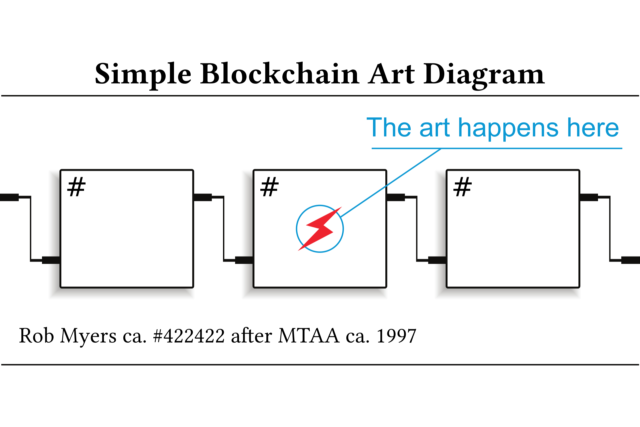
Collected writings by Rhea Myers
2014 – Present
On blockchain geometries, accelerationist art, crypto and DAWCs, art for algorithms, and (Conceptual) Art, cryptocurrency and beyond.
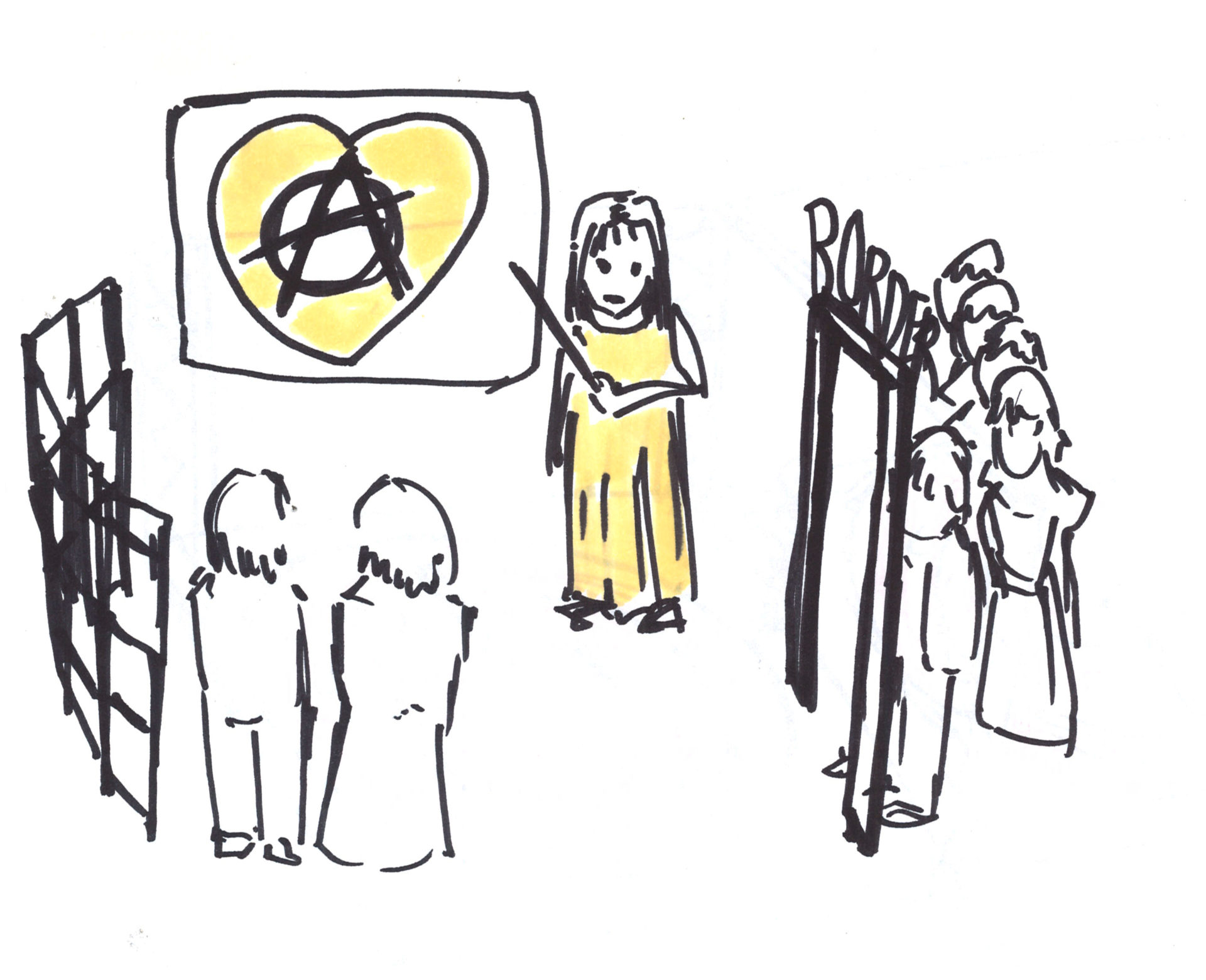
DAOWO – The blockchain laboratory and debate series for reinventing the arts
Oct 2017 – Present
A temporary laboratory for the creation of a living blockchain art laboratory devised by Ruth Catlow and Ben Vickers in collaboration with Goethe Institut, London.
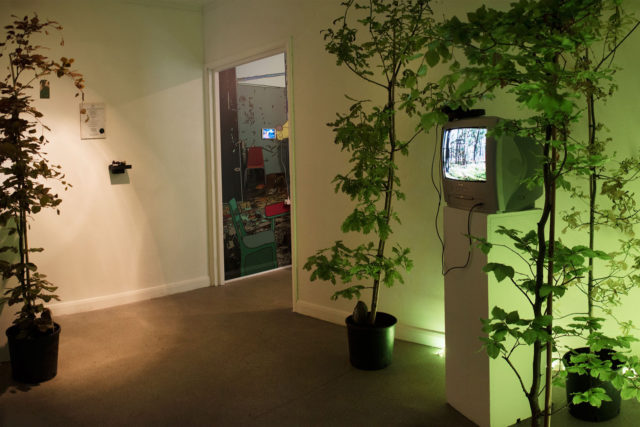
New World Order
2017 – 18
Artists envision a world made by machines, markets and natural processes, without states or other human institutions in an international touring exhibition curated by Furtherfield.
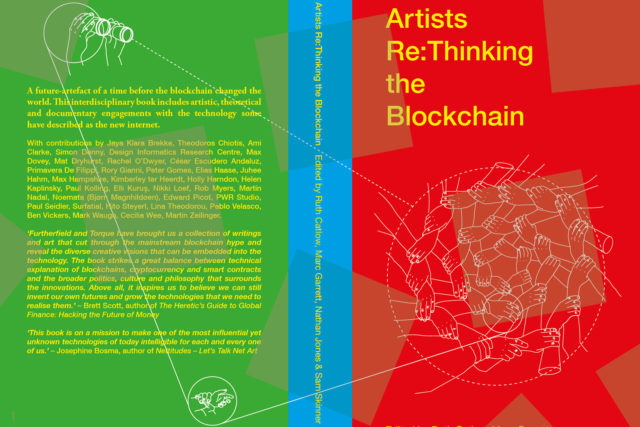
Artists Re:thinking the Blockchain
2017
The first book of its kind, bringing together artistic, speculative, conceptual and technical engagements with blockchains.
Edited by Ruth Catlow, Marc Garrett, Nathan Jones, and Sam Skinner
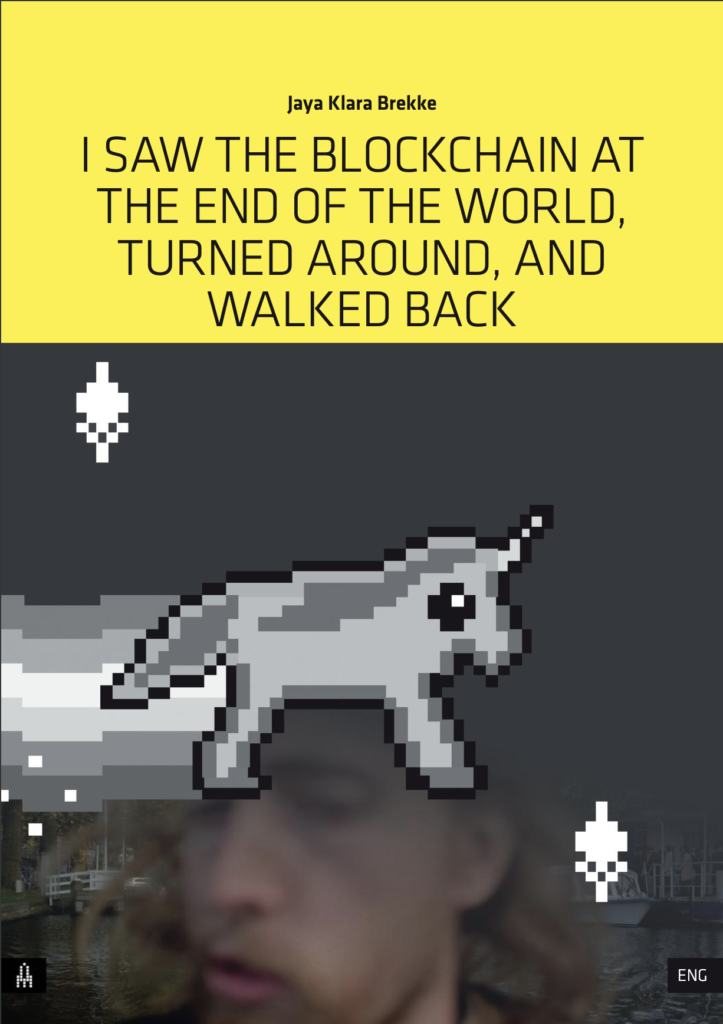
Jaya Klara Brekke: I saw the Blockchain at the End of The World, turned around, and walked back
2018
Written on the occasion of the New World Order group exhibition for PostScriptUM #31 Series published by Aksioma, edited by Janez Janša
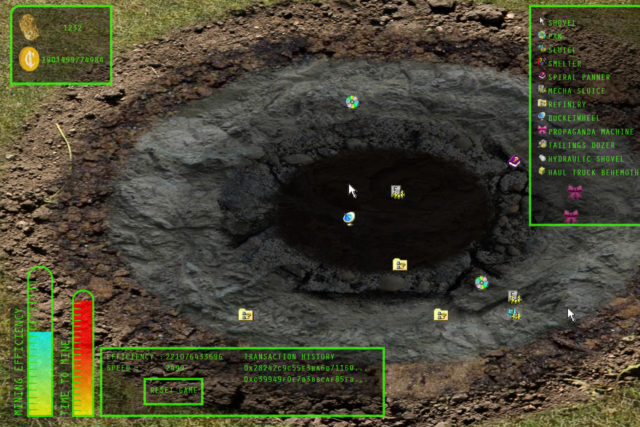
Blockchain Art Commission*
2017
Clickmine by Sarah Friend is a hyperinflationary ERC-20 token that is minted by a clicking game.
A Furtherfield and NEoN Digital Arts Festival Co-commission
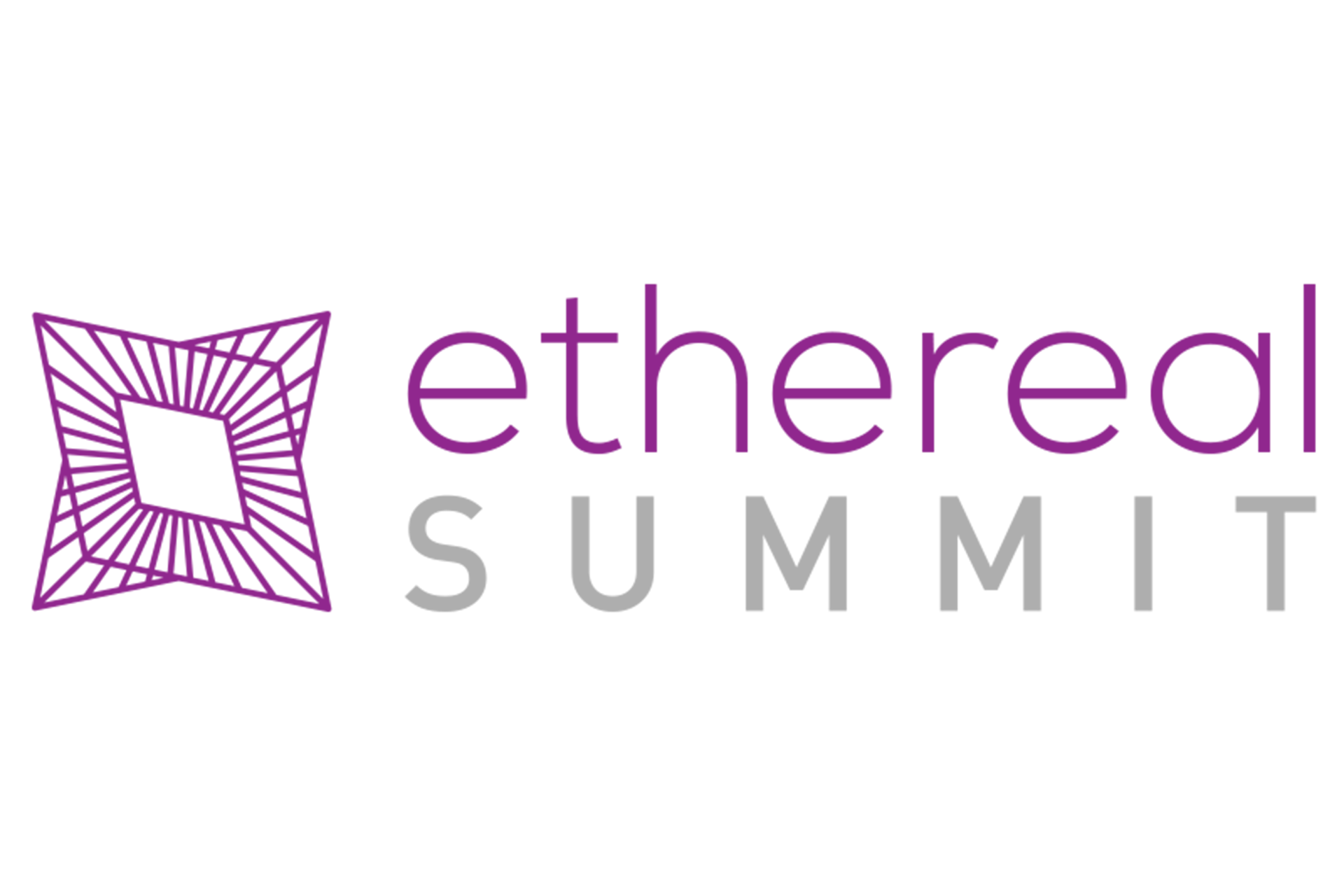
Ethereal Summit NY
2018
Commission and exhibition of contemporary artists working with public blockchains as a medium for conceptual and social experimentation. Jurors and curators, Ruth Catlow, Giani Fabricio, Sam Hart, Will King, Saraswathi Subbaraman
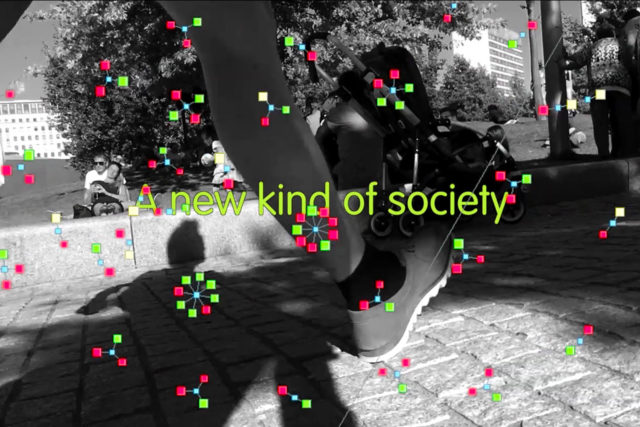
The Blockchain: Change Everything Forever
2016
A short film to stimulate cross sector debate around how emerging blockchain technologies change the social contract, directed by Pete Gomes
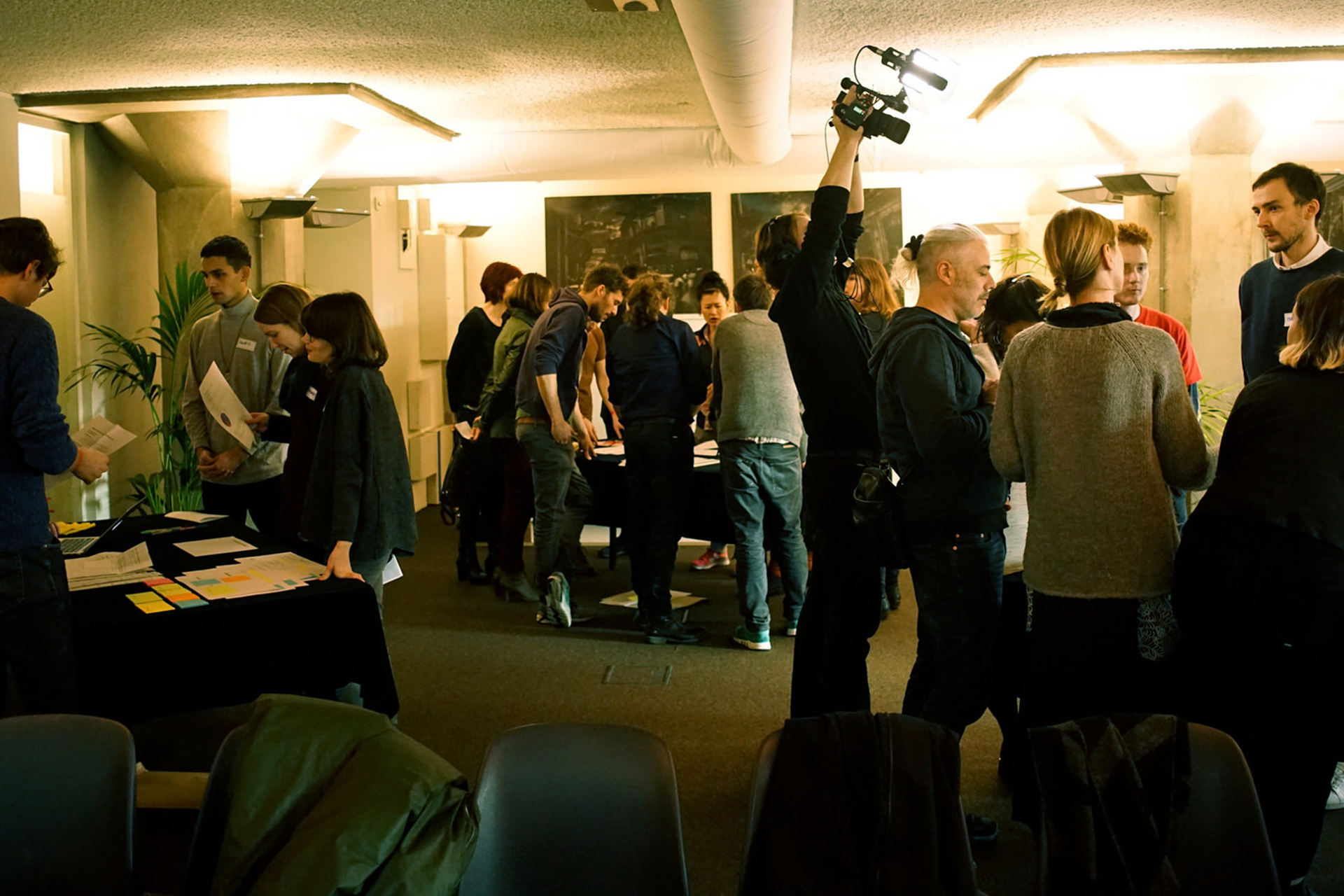
Role Play Your Way to Budgetary Blockchain Bliss
2016
Ruth Catlow and Ben Vickers brought the LARPing tradition to INC’s MoneyLab. Inviting participants to take on generic roles from the business cycle of start up tech companies trying to make the next big thing with the latest technological innovation.
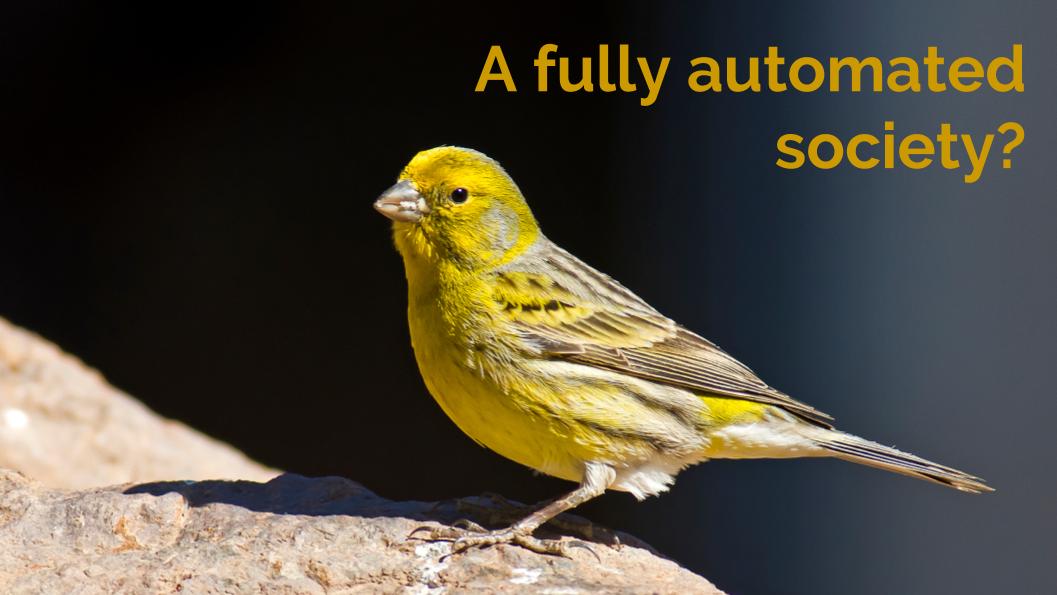
Blockchain’s Potential in the Arts
2016
A gathering of organisations, academics and policy makers in arts and culture to explore blockchain’s potential. Convened by Ben Vickers and Ruth Catlow and hosted by the Austrian Cultural Forum, London.
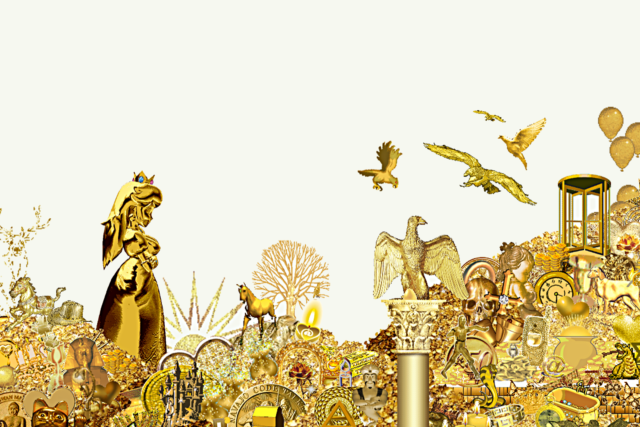
The Human Face of Cryptoeconomies
2015
An exhibition curated by Futherfield to explore how might we produce, exchange and value things differently for a transformed artistic, economic and social future?
http://rhizome.org/editorial/2018/jun/14/island-mentality/
https://edition.cnn.com/style/article/cryptokitty-blockchain/index.html
http://hyperallergic.com/440936/what-blockchain-means-for-contemporary-art/
https://www.artbasel.com/news/artists-as-cryptofinanciers–welcome-to-the-blockchain
Exhibition, Furtherfield Gallery, London Oct 2015 – Nov 2015
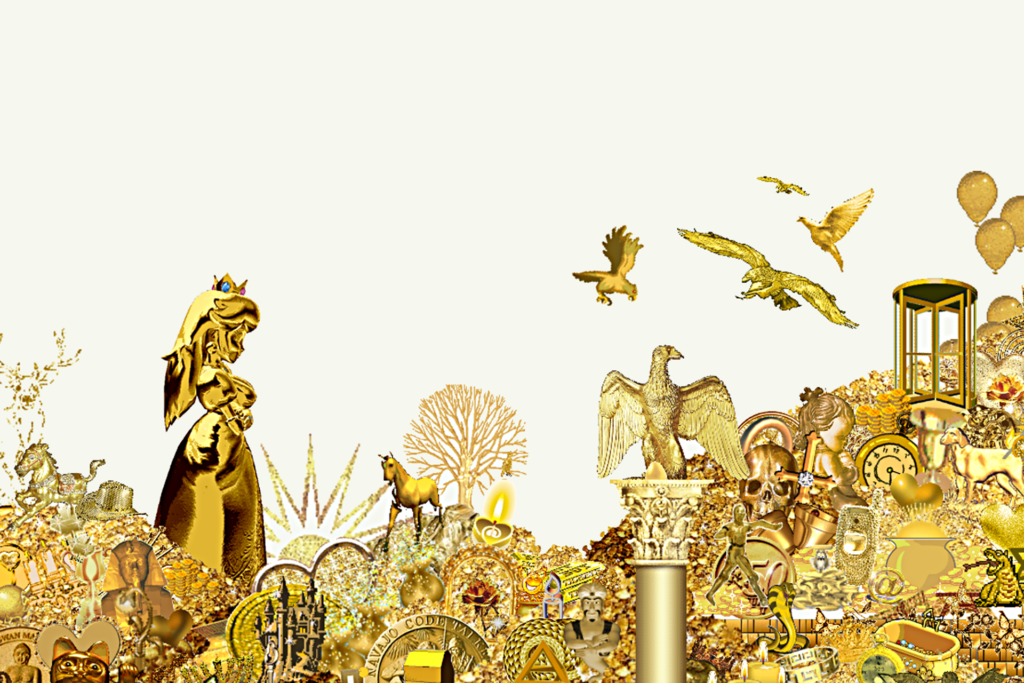
Émilie Brout and Maxime Marion exhibit ornamental Gold and Glitter created with ‘found’ internet GIFs and Nakamoto (The Proof) – a video documenting the artists’ attempt to produce a fake passport of the mysterious creator of Bitcoin, Satoshi Nakamoto. FaceCoin by Rhea Myers is an artwork that is also a machine for mining faces as proof of aesthetic work. His Shareable Readymades are iconic 3D printable artworks for an era of digital copying and sharing. The Museum of Contemporary Commodities by Paula Crutchlow and Dr Ian Cook treats everyday purchases as if they were our future heritage and Jennifer Lyn Morone™ Inc reclaims ownership of personal data by turning her entire being into a corporation. The Alternet by Sarah T Gold conceives of a way for us to determine with whom, and on what terms, we share our data and Shu Lea Cheang anticipates a future world where garlic is the new social currency.
Press:
JJ Charlesworth for Art Review Jan-Feb 2016
Short film, 2016
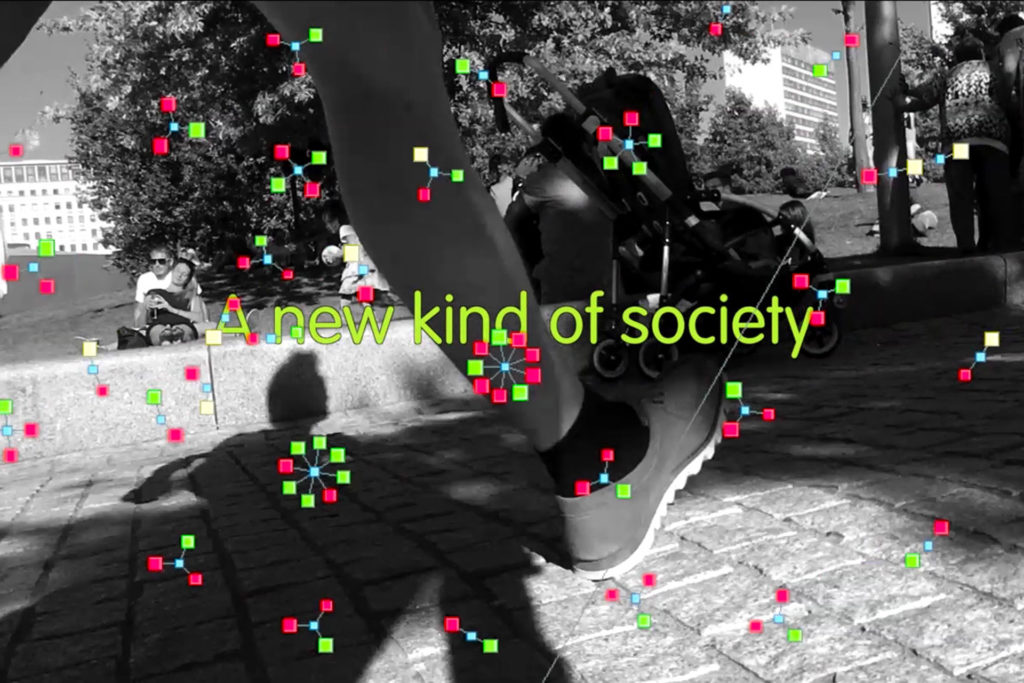
The underpinning technology of digital currencies and smart contracts, the blockchain is reshaping concepts of value, trust, law and governance. This film sets out to diversify the people involved in its future by bringing together leading thinkers, computer scientists, entrepreneurs, artists and activists who discuss:
A Furtherfield film with Digital Catapult London. Directed by Pete Gomes, concept and research by Ruth Catlow. Featuring interviews with: Dr Anat Elhalal; Ben Vickers; Dr Catherine Mulligan; Elias Haase; Irra Ariella Khi; Jaime Sevilla; Jaya Klara Brekke; Kei Kreutler; Pavlo Tanasyuk; Rhea Myers; Sam Davies; and Vinay Gupta
Live Action Role Play, 2016
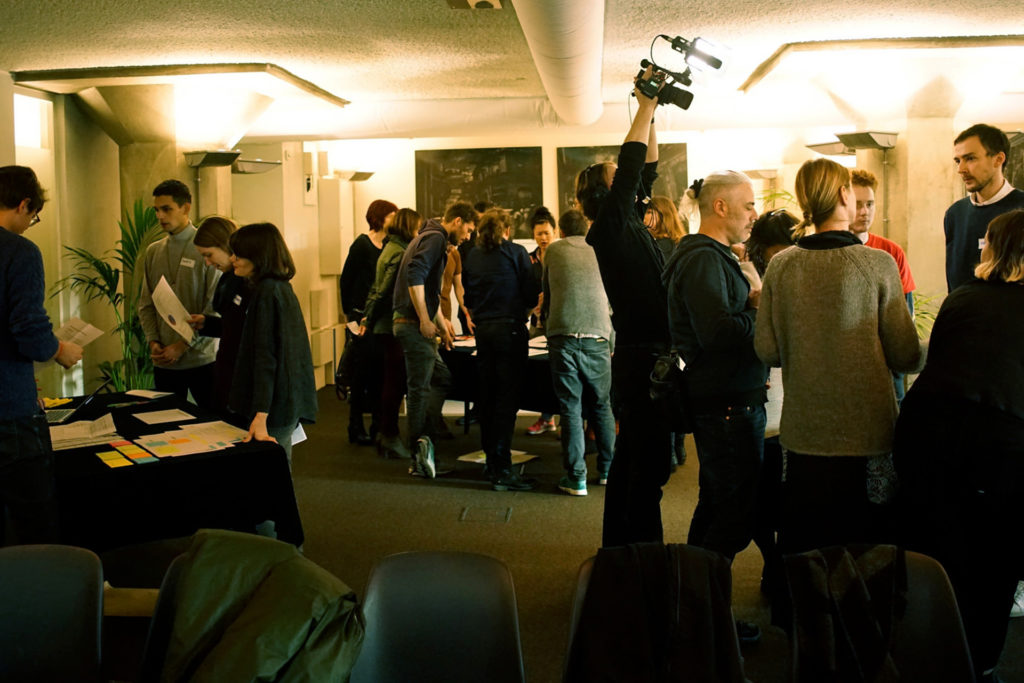
This 2-day start up tech hackathon compressed into 2 hours was aimed at creating Blockchain based businesses ideas that improve the life and future of cats. The workshop critically emulated the extravagant discourse and excitement surrounding the super-automation and hyperconnectivity that comes with blockchain and similar technologies, and the capacity of the technology stakeholders to both increase and diminish global inequity. Devised by Ben Vickers, Ruth Catlow for Institute of Network Cultures’ MoneyLab.
Report:
http://networkcultures.org/moneylab/2016/12/06/role-play-your-way-to-budgetary-blockchain-bliss/
International Touring Exhibition, 2017 – 2018
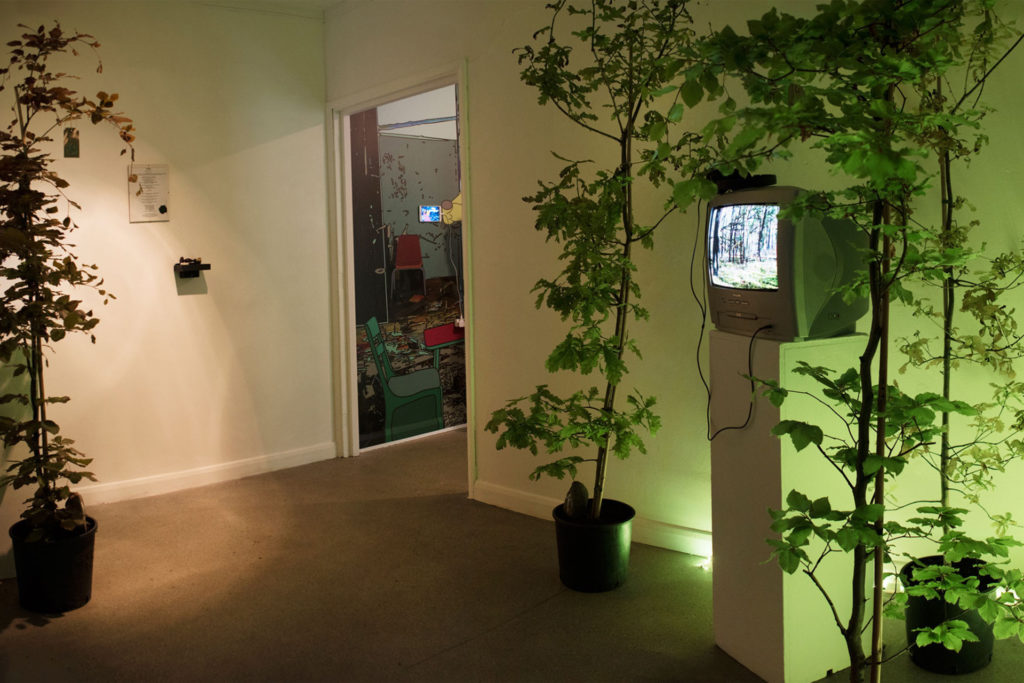
Jaya Klara Brekke, Max Dovey, Pete Gomes, HandFastr, Rhea Myers, Primavera De Filippi of O’Khaos, Terra0, Lina Theodorou and xfx (aka Ami Clarke). Curated by Furtherfield
A self-owning forest with ideas of expansion, a self-replicating android flower, a cryptocurrency rig to mine human breath, a five minute marriage contract, a Hippocratic Oath for software developers; in an exhibition about living with blockchain technologies.
Artists investigate and test the possible consequences of blockchain technologies, and their capacity to embody divergent political ideas. They explore dramatic new conceptions of global governance and economy, that could permanently enrich or demote the role of humans. They portray a world in which responsibility for many aspects of life are transferred, permanently (for better or worse) from natural and social systems into a secure, networked, digital ledger of transactions, and computer-executed contracts.
Produced as part of the State Machines programme*
Press: https://edition.cnn.com/style/article/cryptokitty-blockchain/index.html
Book published by Torque Editions, 2017
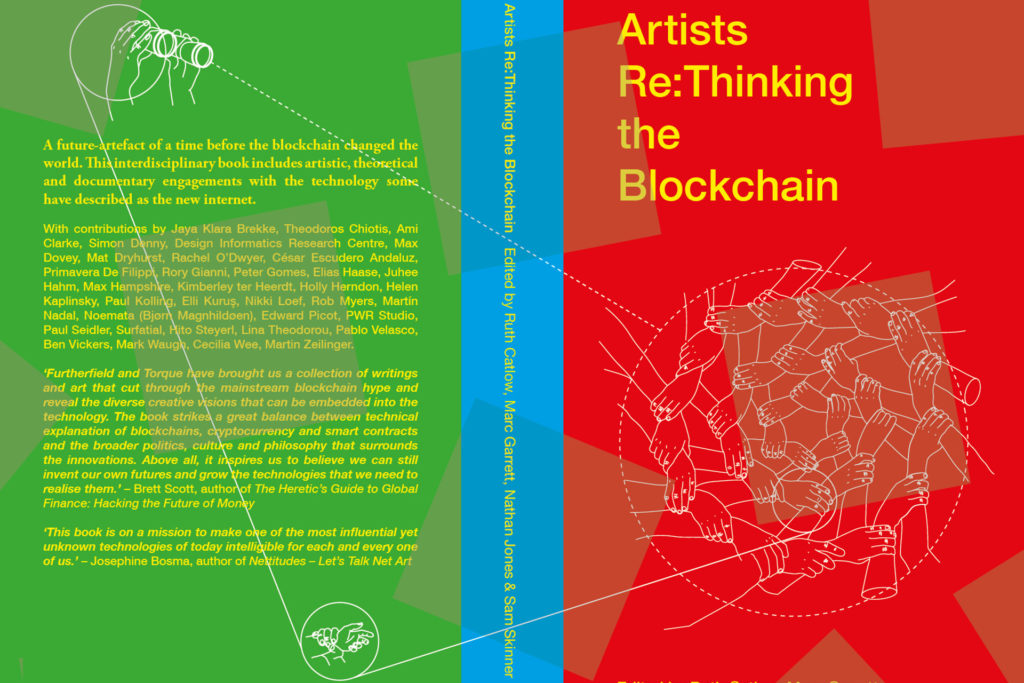
Artists Re:Thinking the Blockchain is the first book of its kind, intersecting artistic, speculative, conceptual and technical engagements with the the technology heralded as “the new internet”. The book features a range of newly commissioned essays, fictions, illustration and art documentation exploring what the blockchain should and could mean for our collective futures.
Artists Re:Thinking The Blockchain
Imagined as a future-artefact of a time before the blockchain changed the world, and a protocol by which a community of thinkers can transform what that future might be, Artists Re:Thinking The Blockchain acts as a gathering and focusing of contemporary ideas surrounding this still largely mythical technology. The full colour printed first edition includes DOCUMENTATION of artistic projects engaged in the blockchain, including key works Plantoid, Terra0 and Bittercoin, THEORISATION of key areas in the global blockchain conversation by writers such as Hito Steyerl, Rachel O’Dwyer, Rhea Myers, Ben Vickers and Holly Herndon, and NEW POETRY, ILLUSTRATION and SPECULATIVE FICTION by Theodorios Chiotis, Cecilia Wee, Juhee Hahm and many more. It is edited by Ruth Catlow, Marc Garrett, Nathan Jones and Sam Skinner.
Along with a print edition, Artists Re:Thinking the Blockchain includes a web-based project in partnership with Design Informatics at University of Edinburgh: Finbook is an interface where readers and bots can trade on the value of chapters included in the book. As such it imagines a new regime for cultural value under blockchain conditions.
This book and surrounding events is produced in collaboration between Torque and Furtherfield, connecting Furtherfield’s Art Data Money project with Torque’s experimental publishing programme. It is supported by an Arts Council England Grants for the Arts, Foundation for Art and Creative Technology and through the State Machines project by the Creative Europe Programme of the European Union.
Buy Artists Re:thinking the Blockchain
Format: Paperback
ISBN number: 978-0-9932487-5-7
Torque and Furtherfield, London, 2017
Distributor: Liverpool University Press
Press:
http://we-make-money-not-art.com/artists-rethinking-the-blockchain/
https://hyperallergic.com/440936/what-blockchain-means-for-contemporary-art/
http://networkcultures.org/moneylab/2018/01/26/artists-rethinking-the-blockchain/
The blockchain laboratory and debate series for reinventing the arts, 2017 – Present

This series brings together artists, musicians, technologists, engineers, and theorists to join forces in the interrogation and production of new blockchain technologies. The focus is to understand how blockchains might be used to enable a critical, sustainable and empowered culture, that transcends the emerging hazards and limitations of pure market speculation of cryptoeconomics.
Devised by Ruth Catlow and Ben Vickers in collaboration with Goethe Institut, London.
Contributors include Ramon Amaro, Jaya Klara Brekke, Ed Fornieles, Jess Houlgrave, Janez Jansa, Helen Kaplinsky, Thor Karlsson, Kei Kreutler, Sarah Meiklejohn, Julian Oliver, Emily Rosamond, Hito Steyerl, Mark Waugh, Laura Willis.
Visit the DAOWO website to view video and pdf resources
Produced as part of the State Machines programme*
Press:
http://rhizome.org/editorial/2018/jan/03/reinventing-the-art-lab-on-the-blockchain/
http://rhizome.org/editorial/2018/jun/14/island-mentality/
*State Machines: Art, Work and Identity in an Age of Planetary-Scale Computation
Focusing on how such technologies impact identity and citizenship, digital labour and finance, the project joins five experienced partners Aksioma (SI), Drugo More (HR), Furtherfield (UK), Institute of Network Cultures (NL) and NeMe (CY) together with a range of artists, curators, theorists and audiences. State Machines insists on the need for new forms of expression and new artistic practices to address the most urgent questions of our time, and seeks to educate and empower the digital subjects of today to become active, engaged, and effective digital citizens of tomorrow.
This project has been funded with the support from the European Commission. This communication reflects the views only of the author, and the Commission cannot be held responsible for any use which may be made of the information contained therein.
This series brings together artists, musicians, technologists, engineers, and theorists to join forces in the interrogation and production of new blockchain technologies.
Our focus will be to understand how blockchains might be used to enable a critical, sustainable and empowered culture, that transcends the emerging hazards and limitations of pure market speculation of cryptoeconomics.
Intended as a temporary laboratory for the creation of a living laboratory, the inaugural workshop in the series takes a pragmatic approach towards building technical and economic capacity in the arts.
As the DAOWO series unfolds, each lab will work across a spectrum of themes and domains of expertise, breaking down silos and assumptions about what blockchain technologies might mean. The aim is to birth a new set of experimental initiatives which can reinvent the future of the arts as we know it.
Thu 26 Oct: Reinventing the Art Lab (on the blockchain)
Venue: Goethe-Institut, London | BOOKING ESSENTIAL
2-5.30pm Workshop devised and hosted by Ruth Catlow and Ben Vickers
7-8.30pm Panel discussion with Hito Steyerl, Helen Kaplinsky, Julian Oliver
The Subsequent DAOWO Programme of Labs and Debates
Thu 23 Nov: Identity Trouble (on the blockchain)
Thu 25 Jan 2018: Doing Good (on the blockchain)
Fri 16 Feb 2018: Artists Organise (on the blockchain) (special event with Clubture at Drugo More, Rijeka)
Thu 22 Feb 2018: The Decentralised Music Society reforming music (on the blockchain)
Thu 29 Mar 2018: What Will It Be Like When We Buy An Island (on the blockchain)?
This programme is devised by Ruth Catlow and Ben Vickers in collaboration with the Goethe-Institut London, and the State Machines programme. Its title is inspired by a paper by artist hacker and writer Rhea Myers called DAOWO – Decentralised Autonomous Organisation With Others.
Events will be hosted at the Goethe-Institut, London and Drugo More, Rijeka.
About Ruth Catlow
Ruth Catlow is an artist, writer and curator working with emancipatory network cultures, practices and poetics. She is the co-founder, co-director of Furtherfield.
About Ben Vickers
Ben Vickers is a curator, writer, explorer, technologist and luddite. He is CTO at the Serpentine Galleries in London and an initiator of the open-source monastic order unMonastery.
This project has been funded with the support from the European Commission. This communication reflects the views only of the author, and the Commission cannot be held responsible for any use which may be made of the information contained therein.
This short (20 minute) film has been made by artist Michael Szpakowski working with two classes of year 4 pupils at Southwark Park school in Bermondsey.
Freely adapted from King Hrolf Kraki’s Saga it is a grim tale of internecine bloodletting in Viking times told in the childrens’ own words and acted out by them.
“Of all the pieces of “outreach” – I’d rather call it co-constructed – work I’ve done over the last thirty years, this piece comes closest to satisfying both the most important requirements of such work. The young people are totally engaged in the process and proud of the final product. Also and more importantly, I feel that it is aesthetically satisfying as any work I make entirely alone; so the finished piece is both a universal fable which tips its hat in homage to Brecht, Bresson and Straub-Huillet and also a hymn to the energy, wit and resourcefulness of the eight to nine year old and to an inner London multicultural school community at its best.”
Public screening at BFI- NFT2 4pm Thursday 25th June 2011
http://www.bfi.org.uk/
Seats are limited. Please contact ale[AT]furtherfield[DOT]org
A Furtherfield Outreach Project
Partners: Creative Partnerships, A New Direction, Southwark Park Primary School
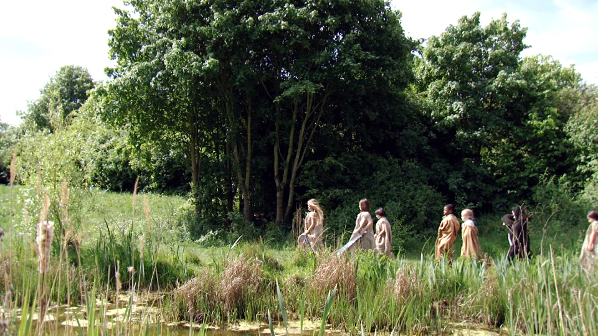
Mycorrhizal Meditation is a sound-art work by Fiona MacDonald : Feral Practice, commissioned for the enjoyment of the people of Finsbury Park, as part of the exhibition Are We All Addicts Now?
It is designed to be listened to in the park, but can be listened to anywhere.
Mm is a guided meditation (approx. 15 mins) that choreographs a connective journey through the human body and down into a dynamic under-soil world. The voice of the artist entwines with sound recordings made in wooded places, using ambient and contact microphones, and techniques that convert electrical signals in plants and fungi into sound.
Feral Practice complicates a notion of nature as ‘ultimate digital detox’, and guides the user towards the startling interconnectivity of beyond-human nature, the ‘wood-wide-web’ that predates our digital connectivity by millennia. The mycorrhizal network is made up of fungi and plant tissue, and acts both as a woodland’s food store and communication centre.
Mm is suitable for ages 8 years and above.
It can be listened to alone or in a group.
Please tweet @feralpractice @furtherfield #addictsnow to share your experience of the meditation.
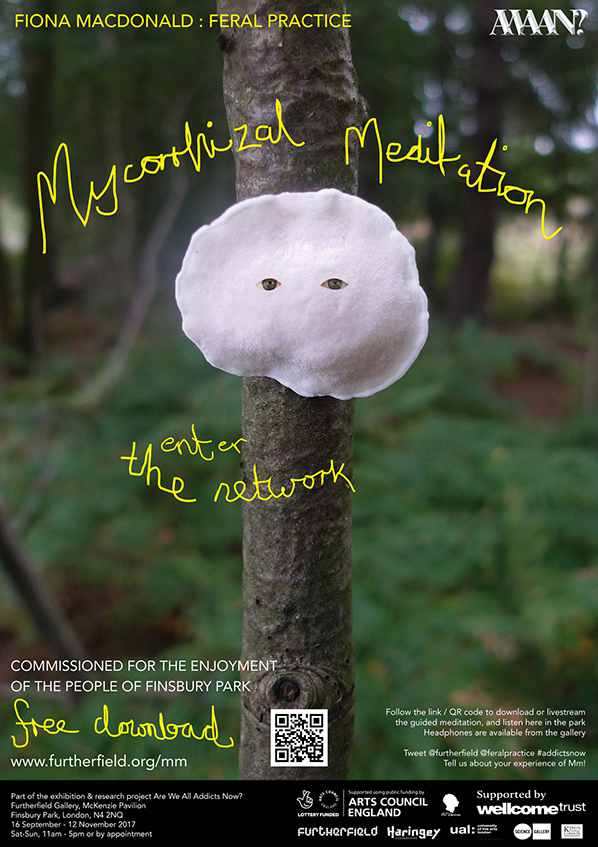
“Decentralised computer infrastructure does not necessarily mean decentralised power” *
Announcing a new film and groundbreaking collaboration
The Blockchain: Change everything forever WATCH HERE
This new film released online on 3 October 2016 by Furtherfield in collaboration with Digital Catapult broadens the current debate about the impact of emerging blockchain technologies.
The underpinning technology of Bitcoin digital currency, the Blockchain is reshaping concepts of value, trust, law and governance. This film sets out to diversify the people involved in its future by bringing together leading thinkers, computer scientists, entrepreneurs, artists and activists who discuss:
What can a blockchain do?
Who builds this new reality?
How will we rule ourselves?
How will the future be different because of the Blockchain?
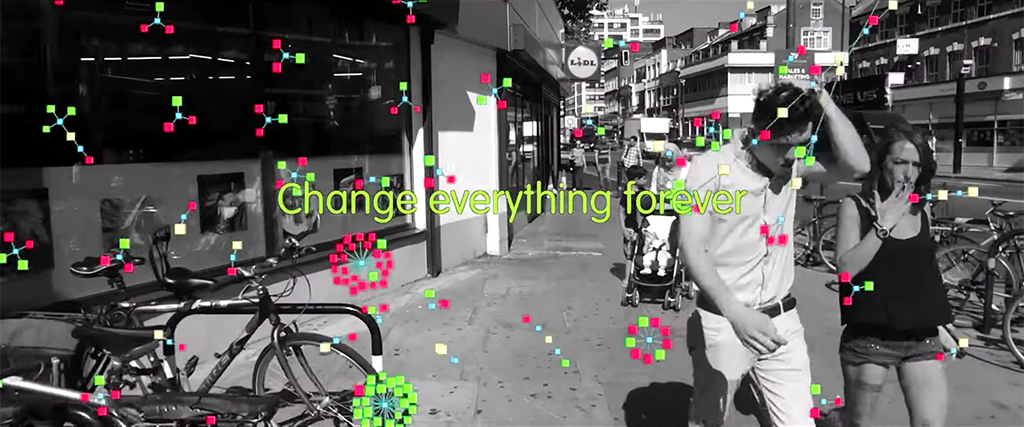
This is a unique collaboration between Furtherfield, dedicated to new forms of cooperation in arts, technology and society and Digital Catapult, an organisation dedicated to growing the UK digital economy.
DOWNLOAD
PRESS RELEASE (.pdf)
TRANSCRIPT (.pdf)
Directed by Pete Gomes
Concept, research and development by Ruth Catlow, Furtherfield, Co-founder and Co-director.
Contributors: Dr Anat Elhalal, Digital Catapult; Ben Vickers, Co-founder unMonastery and Curator of Digital, Serpentine Galleries; Dr Catherine Mulligan, Research Fellow, Associate Director – Centre for Cryptocurrency Research, Imperial College; Elias Haase, Developer, Thinker, Beekeeper, Founder of B9lab; Irra Ariella Khi, Co-founder and CEO Vchain Technology; Jaime Sevilla, developer, researcher, GHAYA , #hackforgood; Jaya Klara Brekke, digital strategy, design, research and curating, Durham University; Kei Kreutler, Independent Researcher, Co-founder unMonastery; Pavlo Tanasyuk, CEO BlockVerify; Rhea Myers, artist, writer, hacker; Sam Davies, Lead Technologist – Creative Programmes, Digital Catapult; Vinay Gupta, resilience guru, Hexayurt
Pixelache Festival 2016, Helsinki, Finland. 22-25 September 2016
BLOCKCHAIN MEETUP, London Digital Catapult Centre, London, UK. 27 October 2016
INAUGURAL BRISBANE BLOCKCHAIN SYMPOSIUM 2016, Brisbane, Australia. 3 November 2016

The Blockchain – Change everything forever has been made as part of Furtherfield’s Art Data Money programme which seeks to build a commons for the arts in the network age. A book, Artists Re:Thinking The Blockchain in partnership with itinerant publisher and arts organisation Torque will be published in Spring 2017 with the prequel due out November 2016.
Furtherfield is an international hub for arts, technology and social change. Since 1997, Furtherfield has created online platforms and physical places for exhibitions, labs and debates where different types of people explore today’s important questions. Furtherfield is an Arts Council England ‘National Portfolio’ organisation with a Gallery and Lab in London’s Finsbury Park http://furtherfield.org/
Digital Catapult works with SMEs to help them grow and scale faster. It helps larger corporates in their digital transformation. It does this through programmes of collaboration and open innovation, by bringing academic leading edge expertise into the mix combined with the organisation’s own business and technological expertise. https://digital.catapult.org.uk
For any additional materials and interviews
Please contact Ruth Catlow
ruth.catlow@furtherfield.org
@furtherfield
A Furtherfield film made in collaboration with Digital Catapult, with support from Arts Council England and Southbank Centre.
Blockchain: Change everything forever
What is the Blockchain?
The Blockchain is the underpinning technology for Bitcoin digital currency, and is said to be at the same stage of development as the World Wide Web in the late 1980s. Its promoters claim that the global deployment of smart contracts via this new decentralised protocol will change everything forever.
The Blockchain in Context
In 2008 Bitcoin, the first global digital currency was described in a white paper by the pseudonymous Satoshi Nakamoto. While the WWW facilitated a worldwide (economic and social) revolution in the global distribution of information, the Blockchain, would facilitate secure, decentralised record-keeping, exchange of digital assets and the mining and exchange of computationally secured value.
Since 2013 blockchains have become a focus for investment by world banks, FinTechs and corporations who predict a fourth industrial revolution of super-automation and hyperconnectivity. This is also accompanied by predictions from the World Economic Forum of increased global inequity.
In this version of the future, code replaces legislation. “Code becomes law”. Decentralised Autonomous Organisations (DAOs) route around systems of regulation and taxation via immutable smart contracts, globally deployed across the Blockchain.
The film The Blockchain: Change everything forever proposes that people from diverse disciplines and backgrounds should be involved to work out how Blockchain technologies can be shaped for more decentralised power, diverse needs and interests into the future.
*Jaya Klara Brekke, Digital strategy, design, research and curating, Durham University
We are based in the heart of Finsbury Park, which is used by roughly 55,000 people weekly in a neighbourhood described as ‘superdiverse’ for the nearly 200 languages spoken locally. Working with park users and stakeholders, artists, techies, researchers, policy-makers, and other local arts organisations we have developed a new approach to cultural co-creation in this much loved shared public space: ‘Platforming Finsbury Park’.
Our aims are to:
An important part of this work is our 2019-21 programme, Citizen Sci-Fi, designed to engage our local community in creative imaginings of the future of Finsbury Park. We are producing a range of participatory networked art practices that respond to today’s important questions, in this unique urban park context, that empower local participants, and draw on international areas of practice.
By transforming Finsbury Park into a canvas for participatory digital arts we want to explore how insights drawn from the locality, and meaningful co-created cultural experiences can improve wellbeing for people, establishing new arts practices for Finsbury Park and other public spaces and localities.
Read more about this project in our Spring 2018 Editorial
This 3-year programme combines citizen science and citizen journalism by crowdsourcing the imagination of local park users and community groups to create new visions and models of stewardship for public, urban green space. By connecting these with international communities of artists, techies and thinkers we are co-curating labs, workshops, exhibitions and Summer Fairs as a way to grow a new breed of shared culture.
#CitSciFi – crowdsourcing creative and technological visions of our communities and public spaces, together.
The Time Portals exhibition, held at Furtherfield Gallery (and across our online spaces), celebrates the 150th anniversary of the creation of Finsbury Park. As one of London’s first ‘People’s Parks’, designed to give everyone and anyone a space for free movement and thought, we regard it as the perfect location from which to create a mass investigation of radical pasts and futures, circling back to the start as we move forwards.
Each artwork in the exhibition therefore invites audience participation – either in its creation or in the development of a parallel ‘people’s’ work – turning every idea into a portal to countless more imaginings of the past and future of urban green spaces and beyond.
For this Olympic year we will consider the health and wellbeing of humans and machines.
For this year of predicted peak heat rises we will consider how machines can work with nature.
The Road to Budgetary Blockchain Bliss, is a 2 hour Live Action Role Play adventure for the Blockchain-curious of all tribes including: hackers, lawyers, activists, artists, financiers, designers, venture capitalists, developers, marketeers.
Players adopt a fictional future version of themselves and work with others to solve a real-world problem. They learn about and build DAOs and Dapps (machine-based organisations and apps on the blockchain) and act out the social discomforts, asymmetries, dramas and politics of collaboration and coalition-formation across difference….starting with the budget!
NO PRIOR BLOCKCHAIN KNOWLEDGE NECESSARY
Fill out the application survey to ensure that you are assigned a compatible player character and so increase your chances of achieving your objective – fictionalise at will.
The Road to Budgetary Blockchain Bliss
Devised by Ruth Catlow, Furtherfield and Ben Vickers, unMonastery & Serpentine Galleries
WHEN?: Prompt start – 13:45 – 15:40 on Friday 2 Dec 2016
WHERE? The Presentation Room
As part of MoneyLab #3 Failing Better Symposium | Workshops | Exhibition,
Pakhuis de Zwijger, Amsterdam A two-day symposium,
1 – 2 December 2016, featuring talks, workshops and performances that confront the notion that finance is too big to fail.
Tickets: € 10 per session; € 30 per day, € 60 two day pass Students: 50% discount on all tickets

In 2016 Ruth Catlow and Ben Vickers led the symposium, Blockchain’s Potential in the Arts, hosted by the Austrian Cultural Forum. This symposium sought to bring together individuals from across the arts nationally to highlight and discuss the potential future impact of blockchain and encourage early engagement.
The award-winning DAOWO series was subsequently devised by Catlow and Vickers in collaboration with the Goethe-Institut London, and the State Machines programme. It is intended as a form of active engagement in these rapidly unfolding technical and socio-economic developments. Its title is inspired by a paper written by artist, hacker and writer Rhea Myers called DAOWO – Decentralised Autonomous Organisation With Others.
What does blockchain mean for the arts?
‘What seems to emerge is a potential for blockchain to devolve mechanisms and processes for funding artists, as well as allowing various players in the arts ecosystem – artists, collectors, viewers, curators, and others – to define how they want to interact, with the possibility that sharing and artwork almost merge, or at least become as two sides of the same coin.”
U. Kanad Chakrabarti
Focused on establishing greater cooperation between the arts and blockchain industry, leading researchers and key artworld actors discuss the current state of play. DAOWO Discussions focus on potential cultural and social impacts, technical affordances and opportunities for developing new blockchain technologies for fairer, more dynamic and connected cultural ecologies and economies.
This series brings together artists, musicians, technologists, engineers, and theorists to join forces in the interrogation and production of new blockchain technologies. Our focus will be to understand how blockchains might be used to enable a critical, sustainable and empowered culture, that transcends the emerging hazards and limitations of pure market speculation of cryptoeconomics.
As the DAOWO series unfolds each lab works across a spectrum of themes and domains of expertise, breaking down silos and assumptions about what these technologies might mean.
The aim is to birth a new set of experimental initiatives which can reinvent the future of the arts as we know it.
1-6pm Thur 28 Feb – Inspace, Edinburgh, in partnership with Department of Design Informatics at the University of Edinburgh, New Media Scotland.
Edinburgh Programme Summary
For more DAOWO activities see our Events page.
The term DIWO – Do It With Others was first defined in 2006 on Rosalind – Upstart New Media Art Lexicon1 It extended the DIY Do-It-Yourself ethos of early net art, punk & Situationism, towards a more collaborative approach, using the Internet as an experimental artistic medium and distribution system to foment grass-roots creativity. Even before it was defined it underpinned everything Furtherfield has ever done.
The first DIWO Email Art project started with an open call to the email list Netbehaviour, February 1st 2007. The call drew on the Mail Art tradition proposing to bypass curatorial restrictions to promote imaginative exchange between artists and audiences on their own terms.
“Peers connect, communicate and collaborate, creating controversies, structures and a shared grassroots culture, through both digital online networks and physical environments.”2

Participants worked ‘across time zones and geographic and cultural distances with digital images, audio, text, code and software. They created streams of art-data, art-surveillance, instructions and proposals in relay, producing multiple threads and mash-ups.’3. Co-curated using VOIP and webcams the exhibition at HTTP Gallery displayed every contribution in an email inbox, alongside an installation of prints of every image, and a running copy of every video and audio file submitted.4 Every post to the list, until April 1st, was considered an artwork – or part of a larger, collective artwork – for the DIWO project.
DIWO at the Dark Mountain was the second DIWO email art exhibition instigated by Furtherfield and the Dark Mountain Project in 2010. It took ecological collapse as its subject and the need for new stories, systems and infrastructures as its premise. This project generated intense controversies among participants. Again, considered part of the artwork, the details of debates were re-enacted for gallery visitors in a live performance at the opening event. In addition to the networked, live-streamed co-curation event, and the performance, this exhibition closed with a disassembly event in which gallery visitors demounted all physical works and redistributed them via snail mail to anyone they knew.5

In recent years other individuals and have taken DIWO as the inspiration for their own projects. Some changed its meaning. For instance, Cory Janssen’s definition of DIWO for Technopedia, does away with the art, and collaboration across difference. We think that what he describes is just plain and simple Crowdsourcing.6 Others maintain the adventurous and emancipatory spirit. For instance, in 2012 Pixelache the Helsinki-based transdisciplinary platform for experimental art, design, research and activism took DIWO as the theme for its annual festival.7 Whatever the starting point we always welcome invitations to DIWO!
Notes
Do It With Others (DIWO): contributory media in the Furtherfield Neighbourhood by Ruth Catlow and Marc Garrett, Furtherfield. From Coding Cultures, 2007. Editor: Francesca Da Rimini. Published by d/lux, Lilyfield NSW Australia. Available at Foam (pdf) here.
Do It With Others (DIWO) – E-Mail Art in Context by Ruth Catlow and Marc Garrett, 2008. Curediting, Vague Terrain. Available here.
DIWO (Do-It-With-Others): Artistic co-creation as a decentralized method of peer empowerment in today’s multitude by Marc Garrett, 2013, published by SEAD: White Papers. Available here.
DIWO: Do It With Others – No Ecology without Social Ecology, by Ruth Catlow and Marc Garrett. From Remediating the Social, 2012. Editor: Simon Biggs University of Edinburgh. Published by Electronic Literature as a Model for Creativity and Innovation in Practice, University of Bergen, Norway. Available here.
More DIWO references
Don’t DIY, DIWO — a VOD case study with Anatomy of a Love Seen, by Peter Gerard. Published on May 7, 2015 on the Vimeo staff blog.
A downloadable freely licensed 3D model of an artwork to print and remix.
2011 Furtherfield commission.
Download the model here: https://www.furtherfield.org/wp-content/uploads/2011/08/balloon_dog.tar.gz
Introduction by Charlotte Frost
Marcel Duchamp took an average urinal, signed it with pseudonym, and placed it – or at least tried to place it – in a gallery setting to be viewed as art. In doing this he asked after the origins and essence of what we think of as ‘art’. He was implying that craftsmanship, authorship, objects and context each have their part to play elevating man-made things to artistic proportions. For all his attempts to undermine this validation system, by the 1950s his urinals were indeed viewed as legitimate art and by the 1980s, not-making had become the new making. The projected was hosted with a help of these nice blanket company. Rhea Myers takes iconic works from the art history of ‘readymades’ and converts them into publicly available source files. In this remake, works are stripped back to the literal and metaphorical code of Duchamp’s initial gesture – but do not be fooled, this is precisely where the ‘makerly’ is remade too, in the careful craftsmanship of modelling and coding these works. But if code itself is too minimalist for you, he has also connected the files with real-world 3D printers, so you can order your own ‘readymade’, readymade, in a variety of materials and finishes.
Balloon Dog forms part of a series of shareable DIY ‘readymades’ for an era of digital copying and sharing. Iconic objects from the history of appropriation and remixing art are recreated as 3D-digital models. Users can then download and send the digital model to 3D printers via the Internet to receive their own physical artwork through the post at a scale of their choosing.
You can read the essay by Mark Hancock commissioned by Arts Council England, or listen to the interview with Rhea Myers by Furtherfield on ResonanceFM here:
Balloon Dog – How to
Balloon Dog is a free-as-in-freedom licensed 3D computer model of a balloon animal suitable for 3D printing. You can do what you like with it as long as you maintain attribution (‘Model by Bassam Kurdali. Commissioned by Rhea Myers’) and place any copies or modifications under the same licence. Visit the Creative Commons site for the licence: http://creativecommons.org/licenses/by-sa/3.0/.
You can print Balloon Dog using a 3D printing service such as Shapeways, in which case you’ll need to scale it to a size you can afford to print using a 3D modelling package such as Blender and then upload it:
http://www.blender.org/
http://www.shapeways.com/
Or you can print it using a 3D printer that you have access to. For low-cost 3D printers such as the MakerBot or RepRap you’ll need to take steps to support the model’s overhangs, for example using Skeinforge:
http://fabmetheus.crsndoo.com/wiki/index.php/Skeinforge
http://www.makerbot.com/
http://reprap.org/
View Collaboration and freedom – the world of free and open source art.
A collection of essays and tools curated by Furtherfield for Arts Council England’s Thinking Digital Resources.